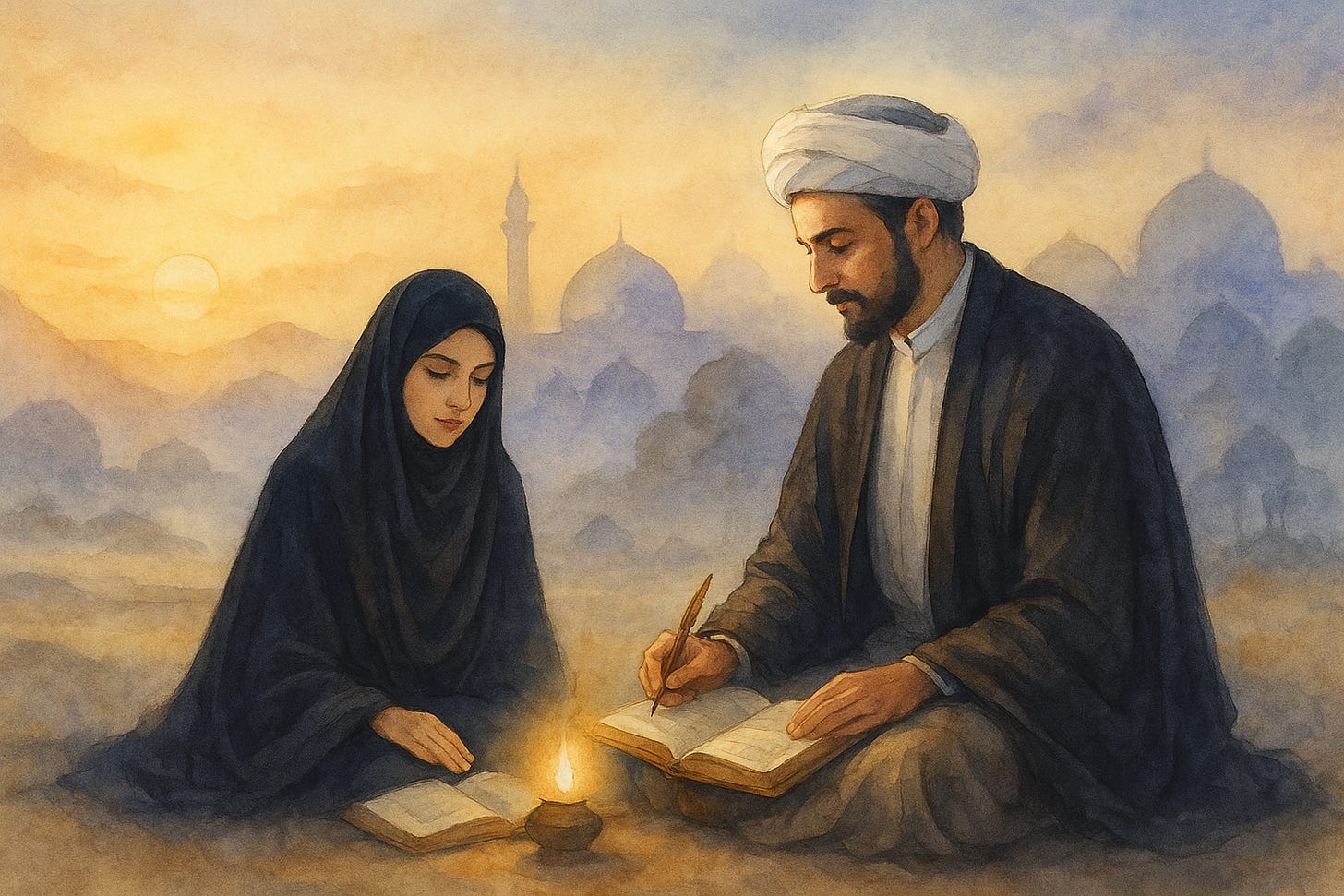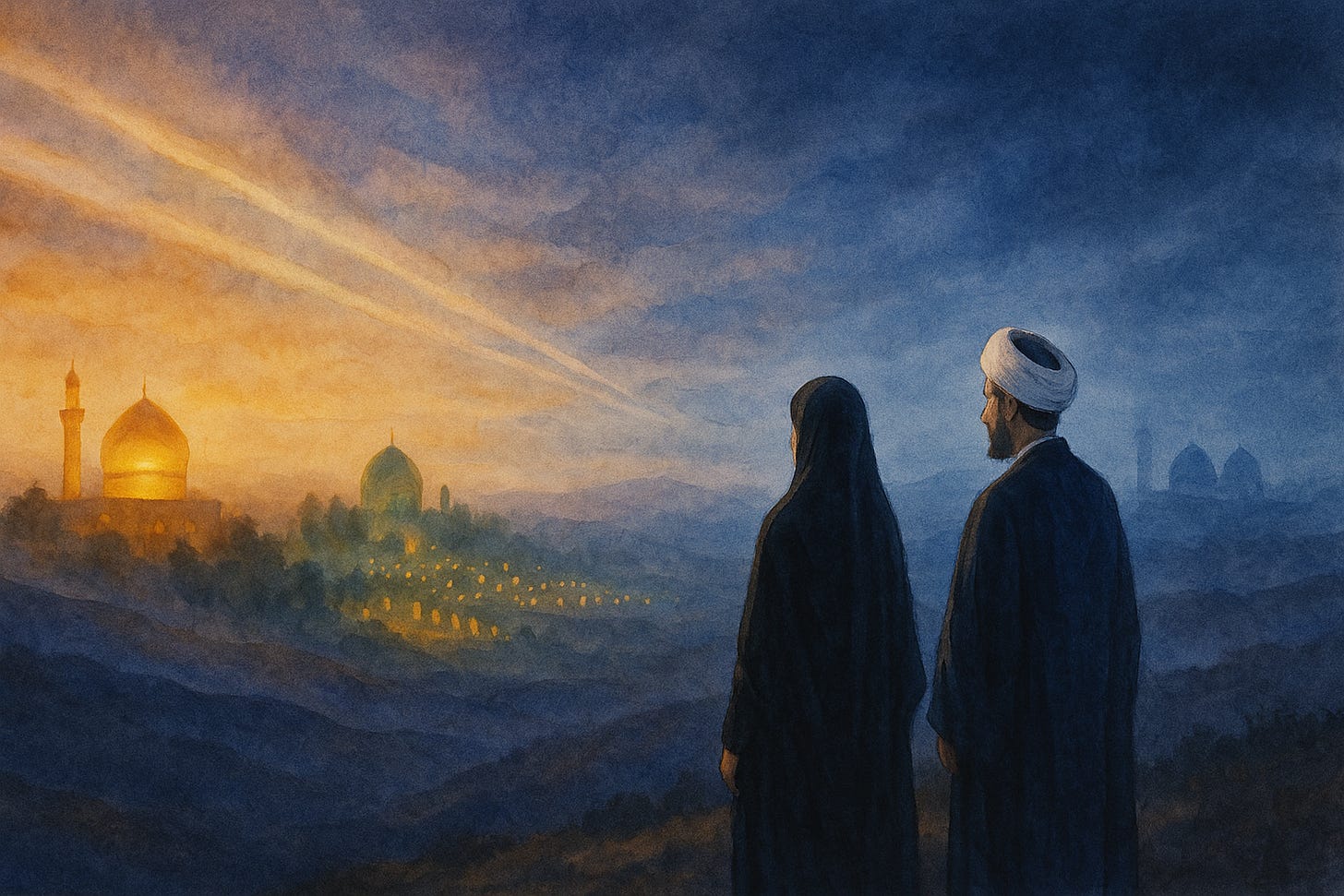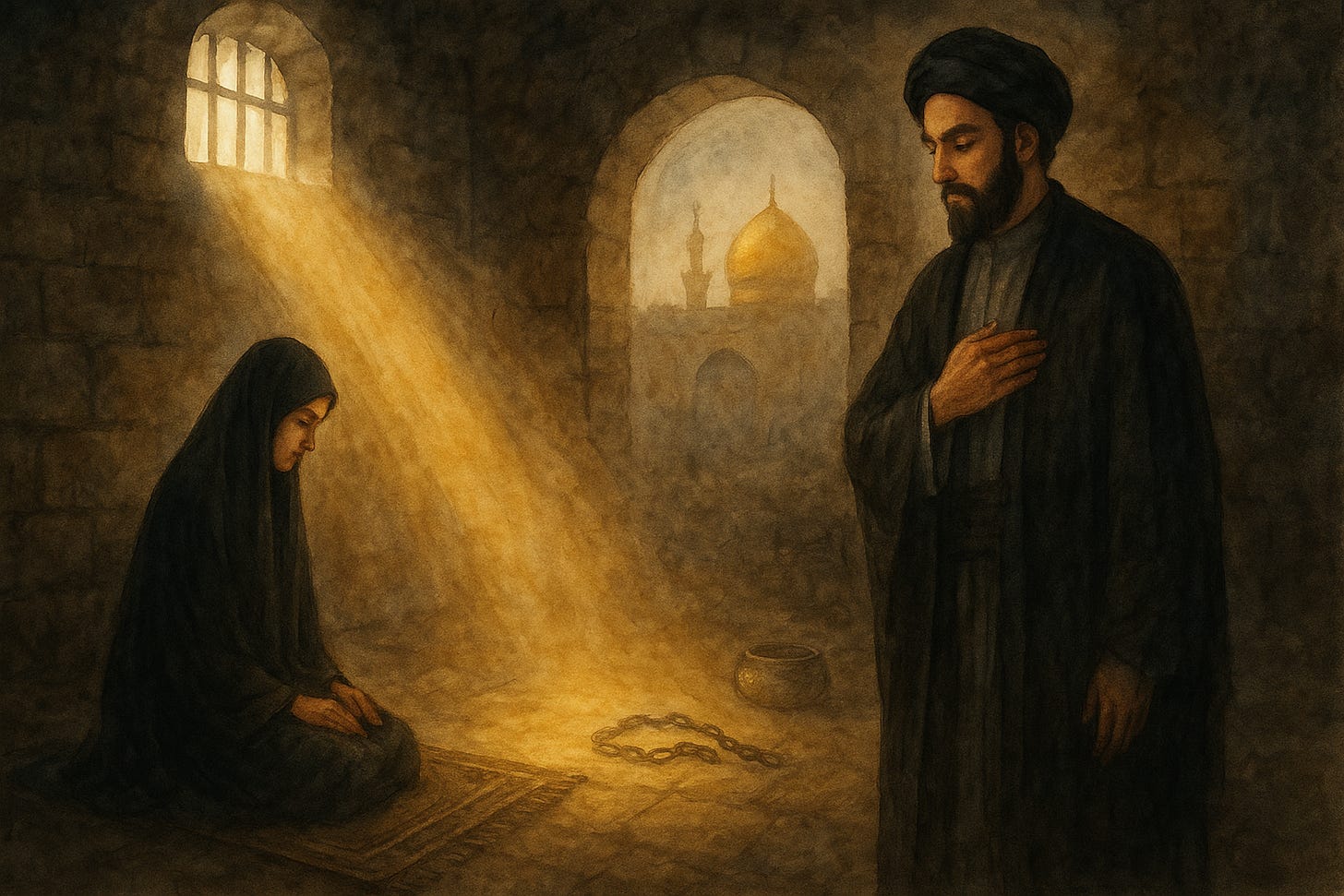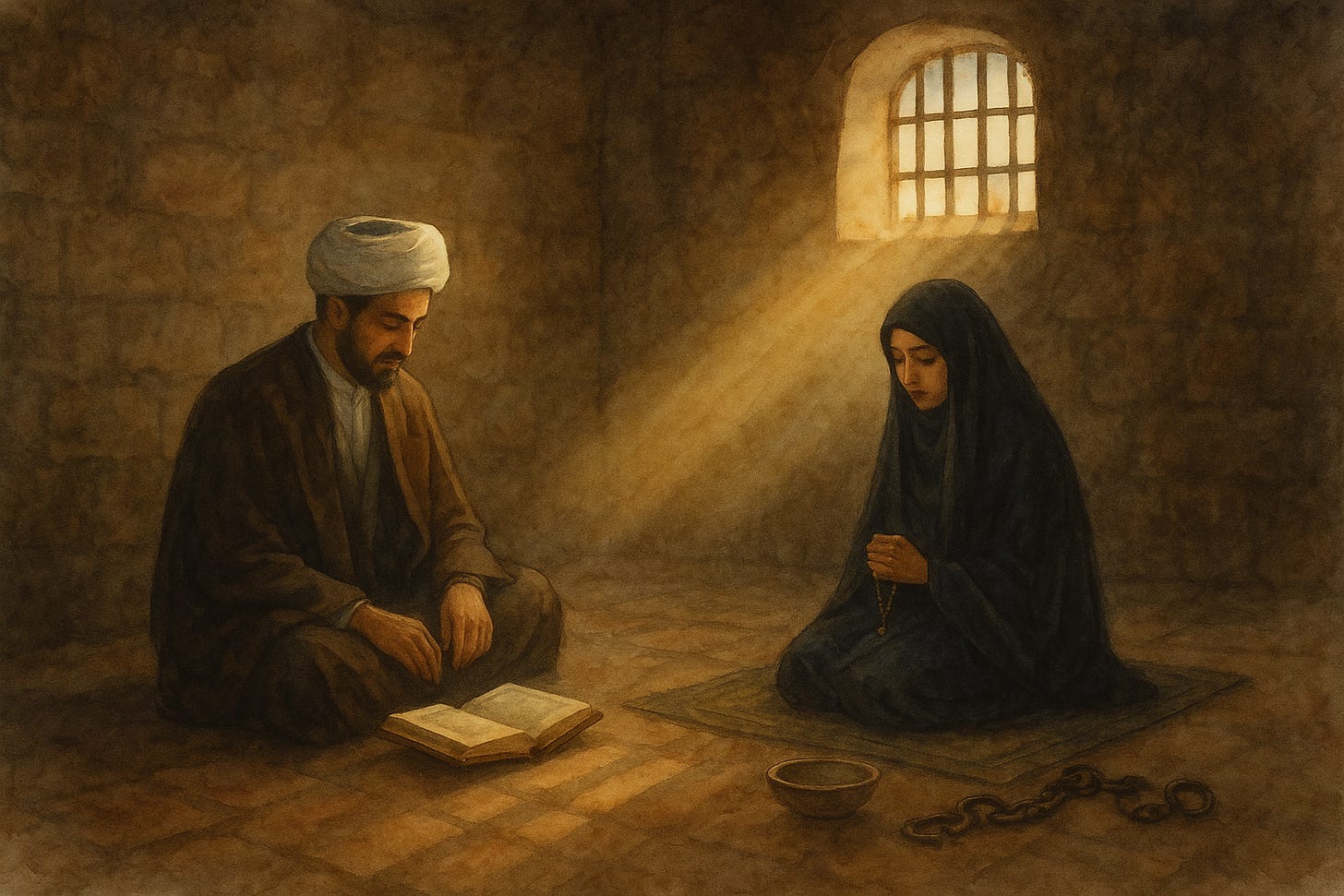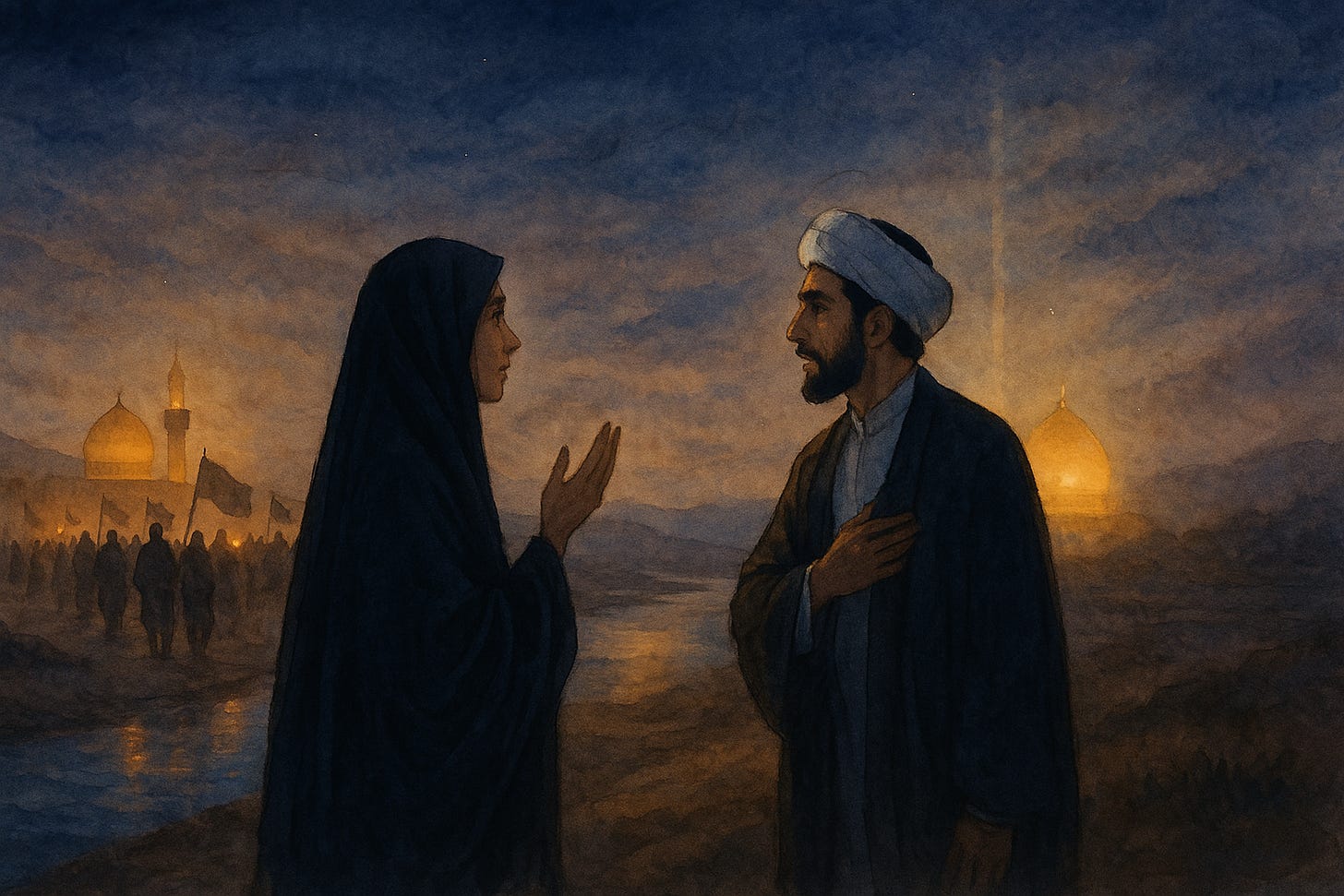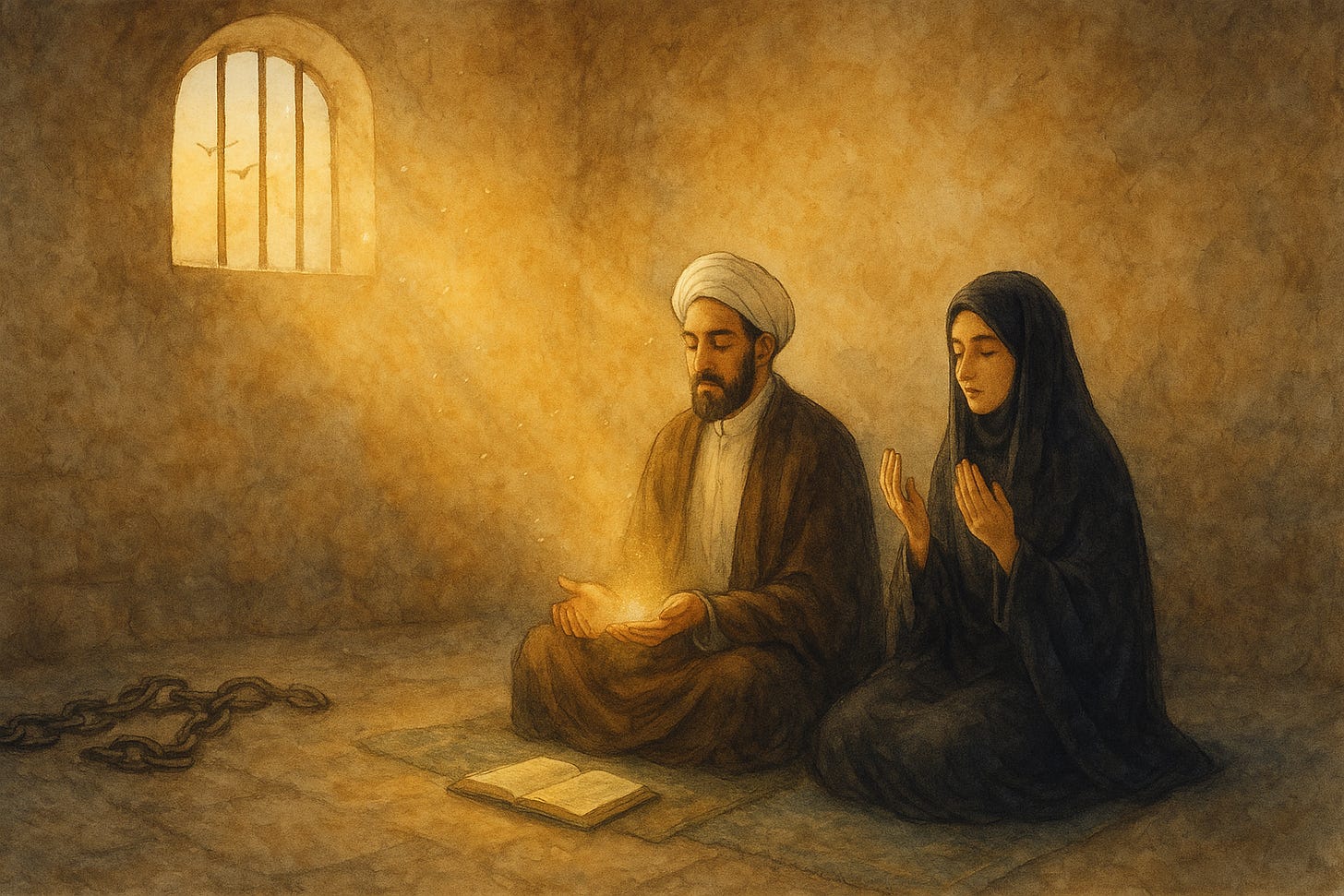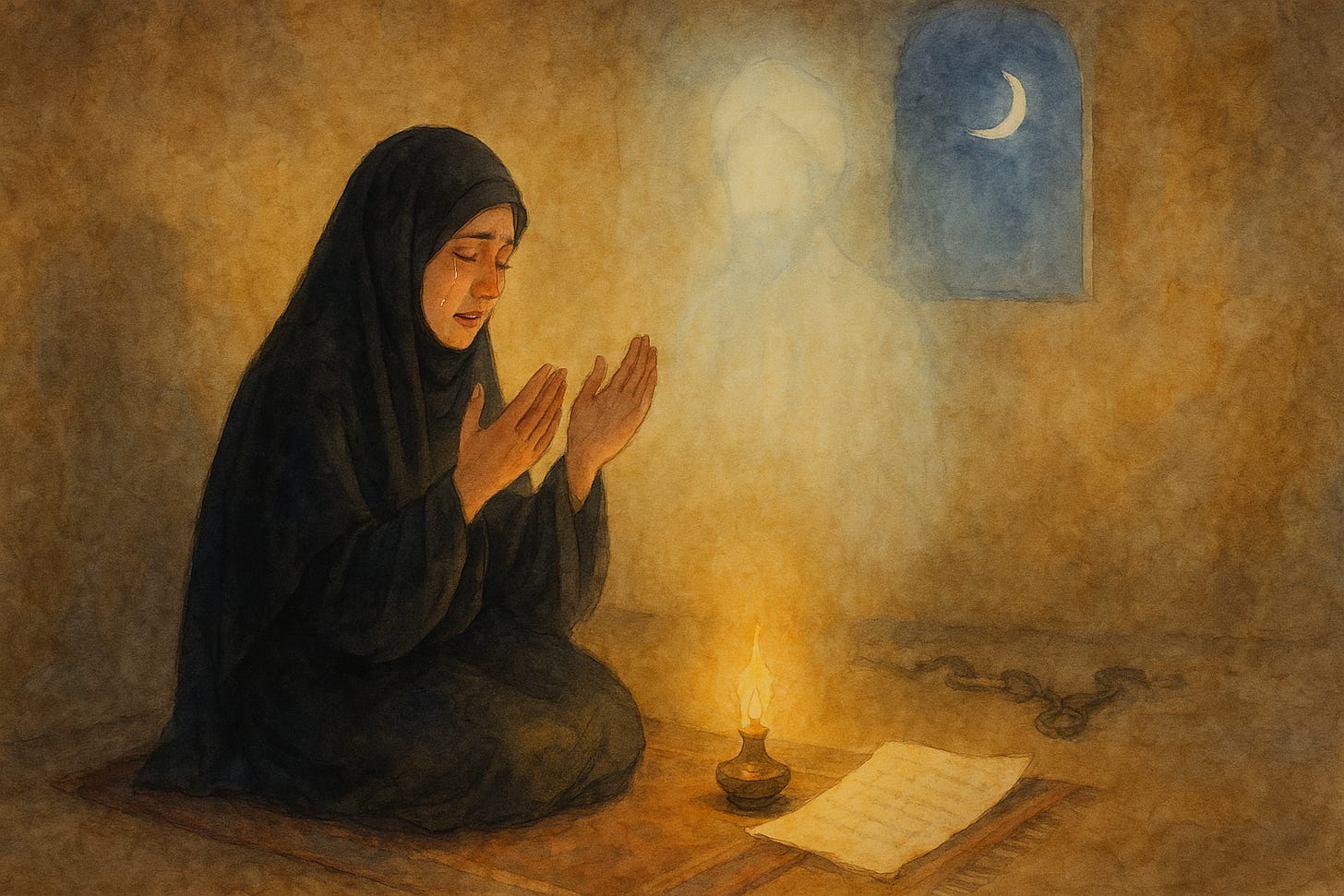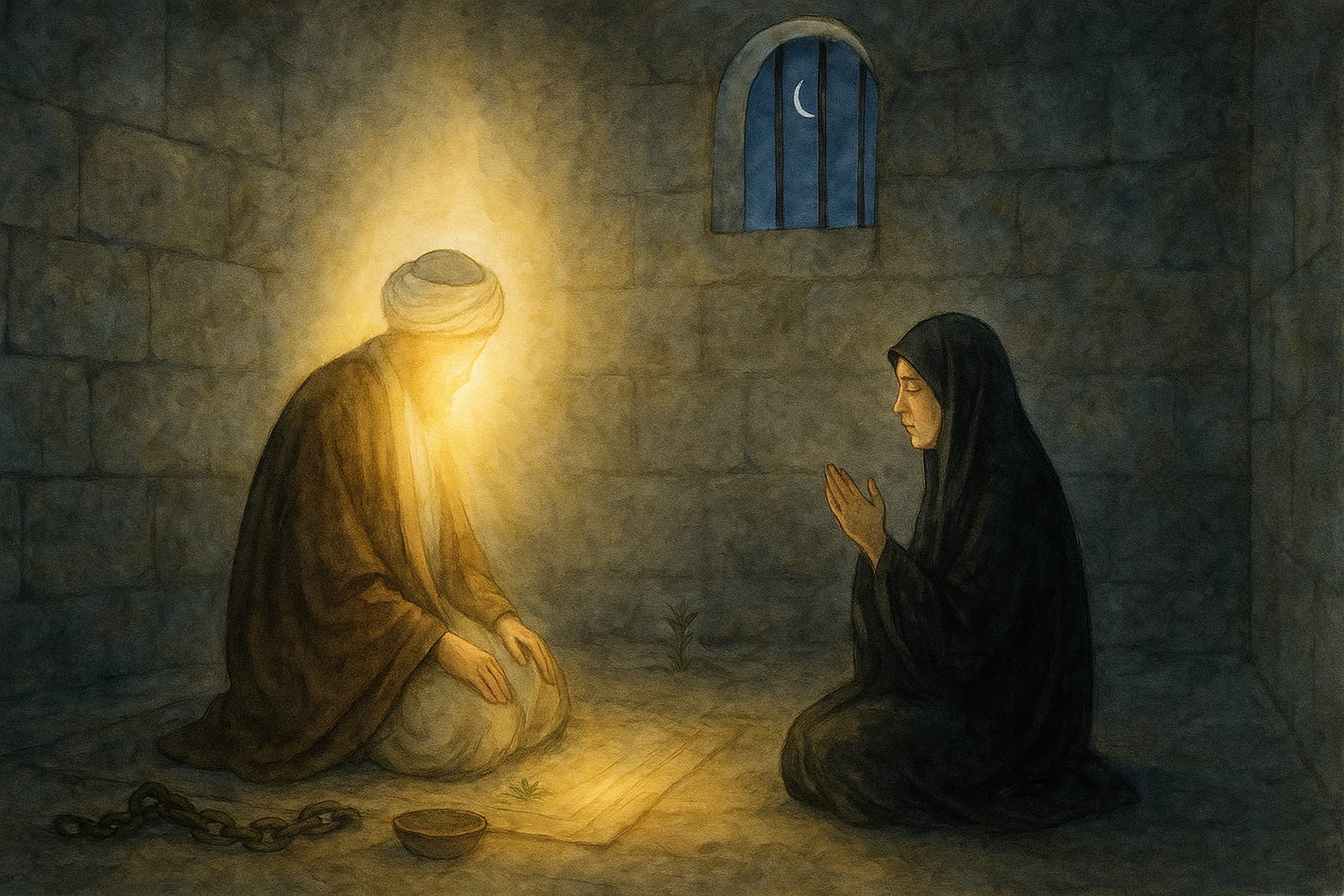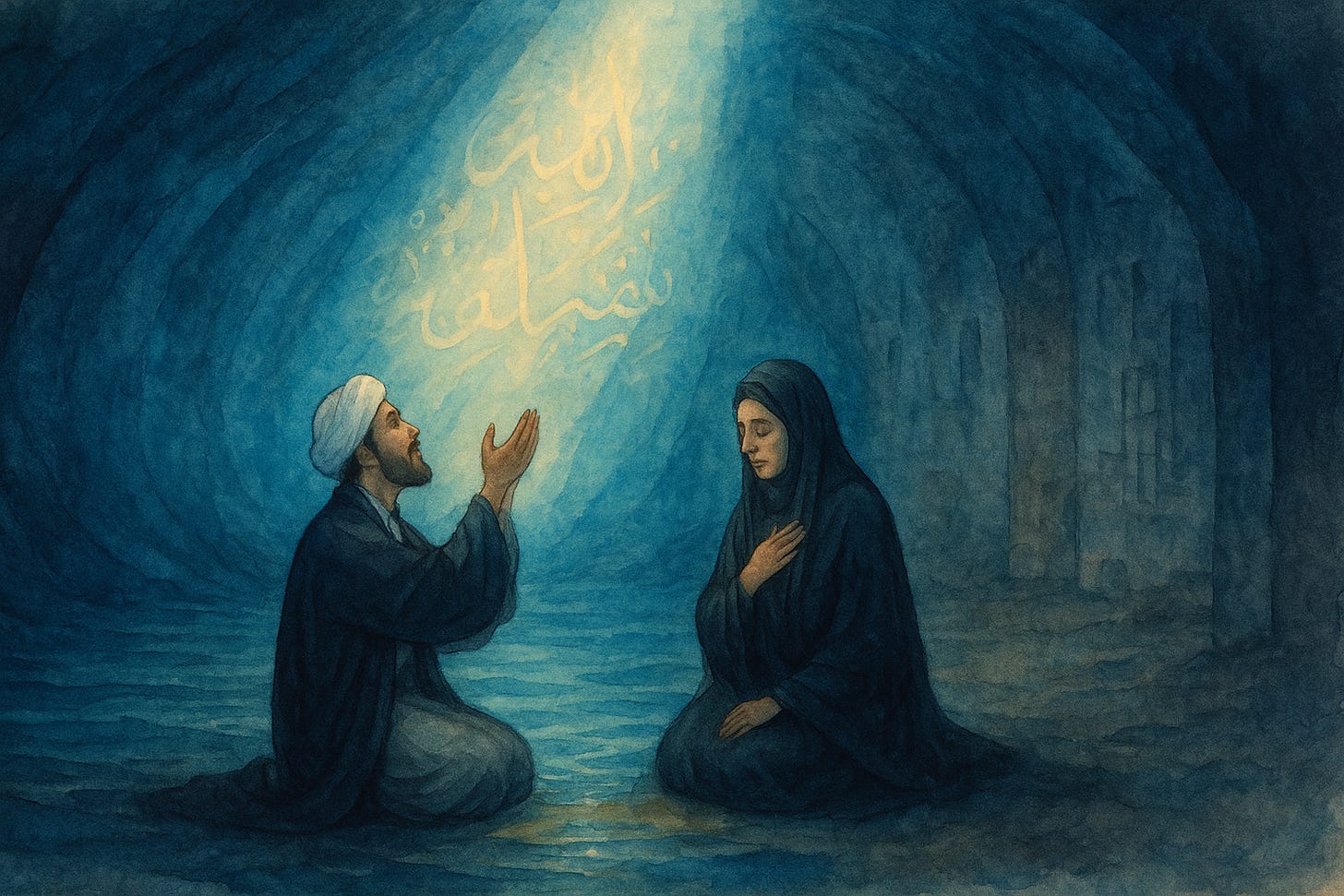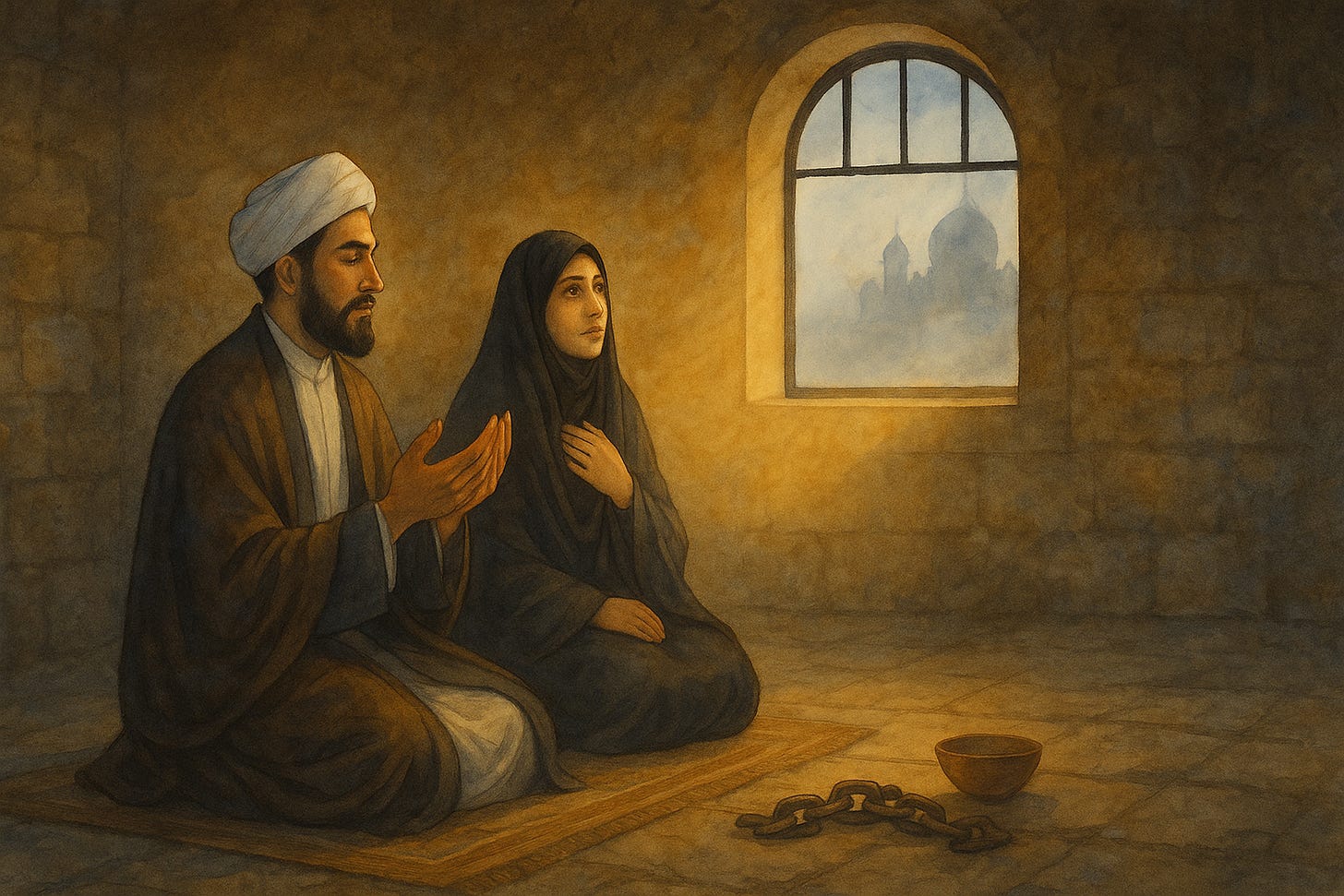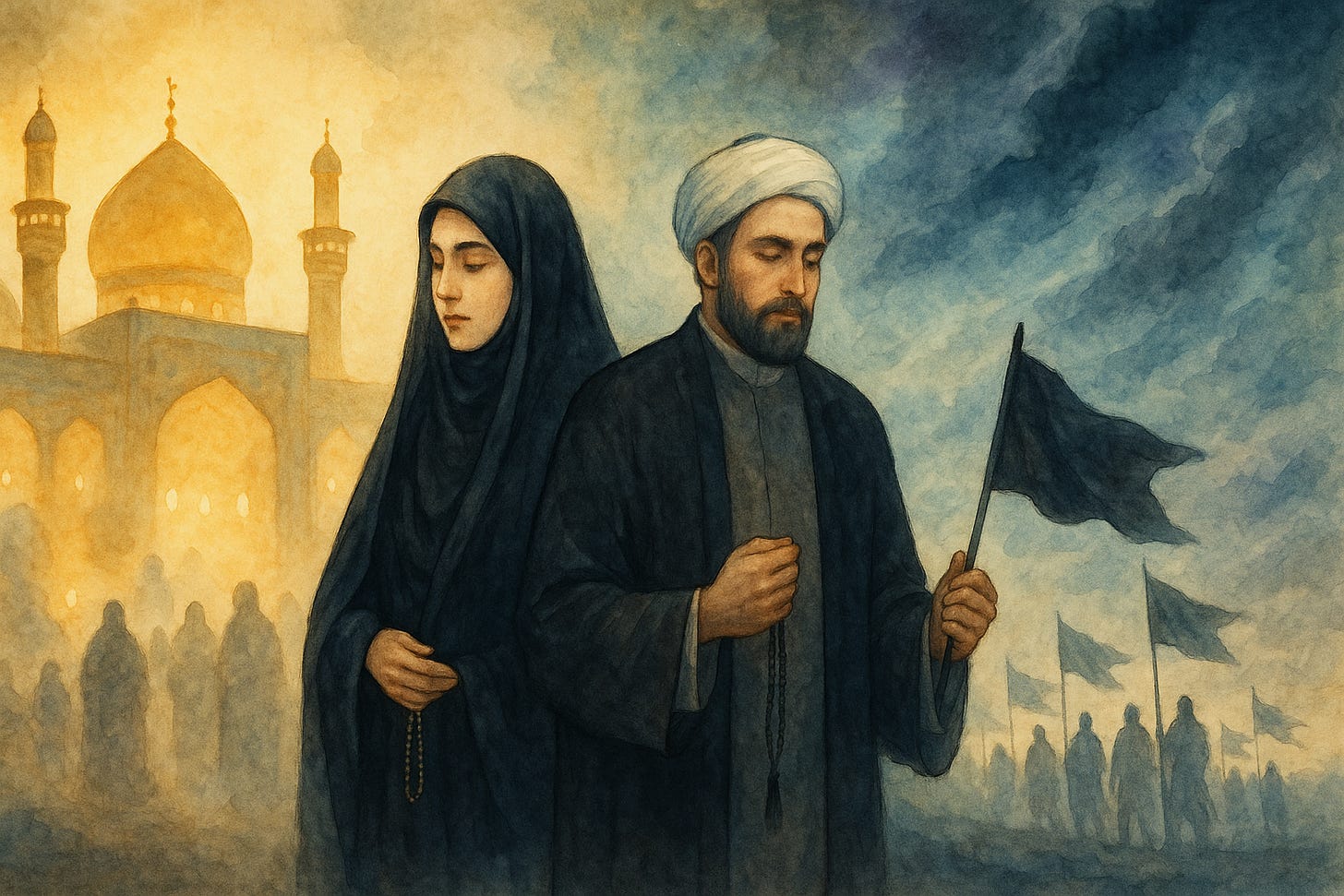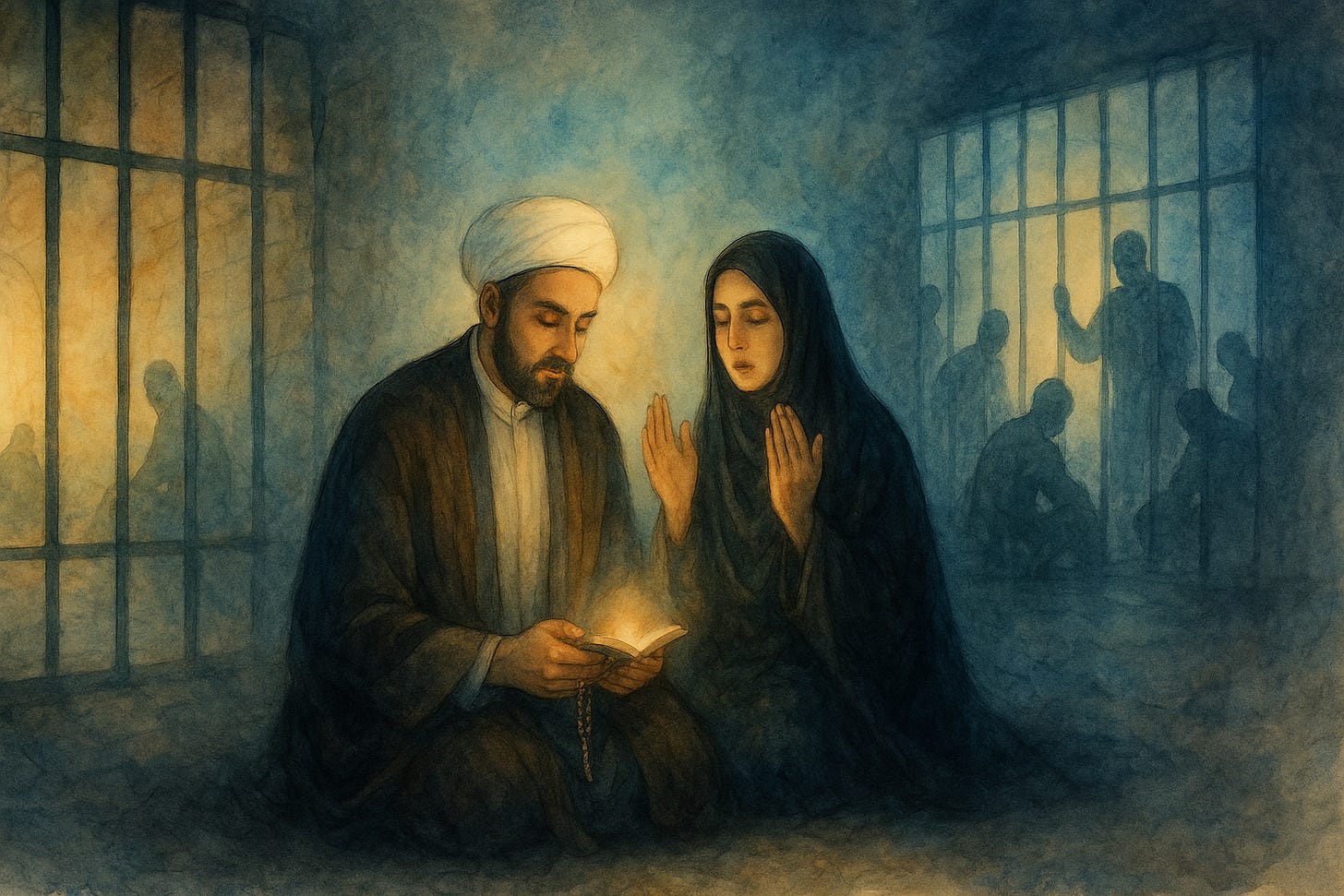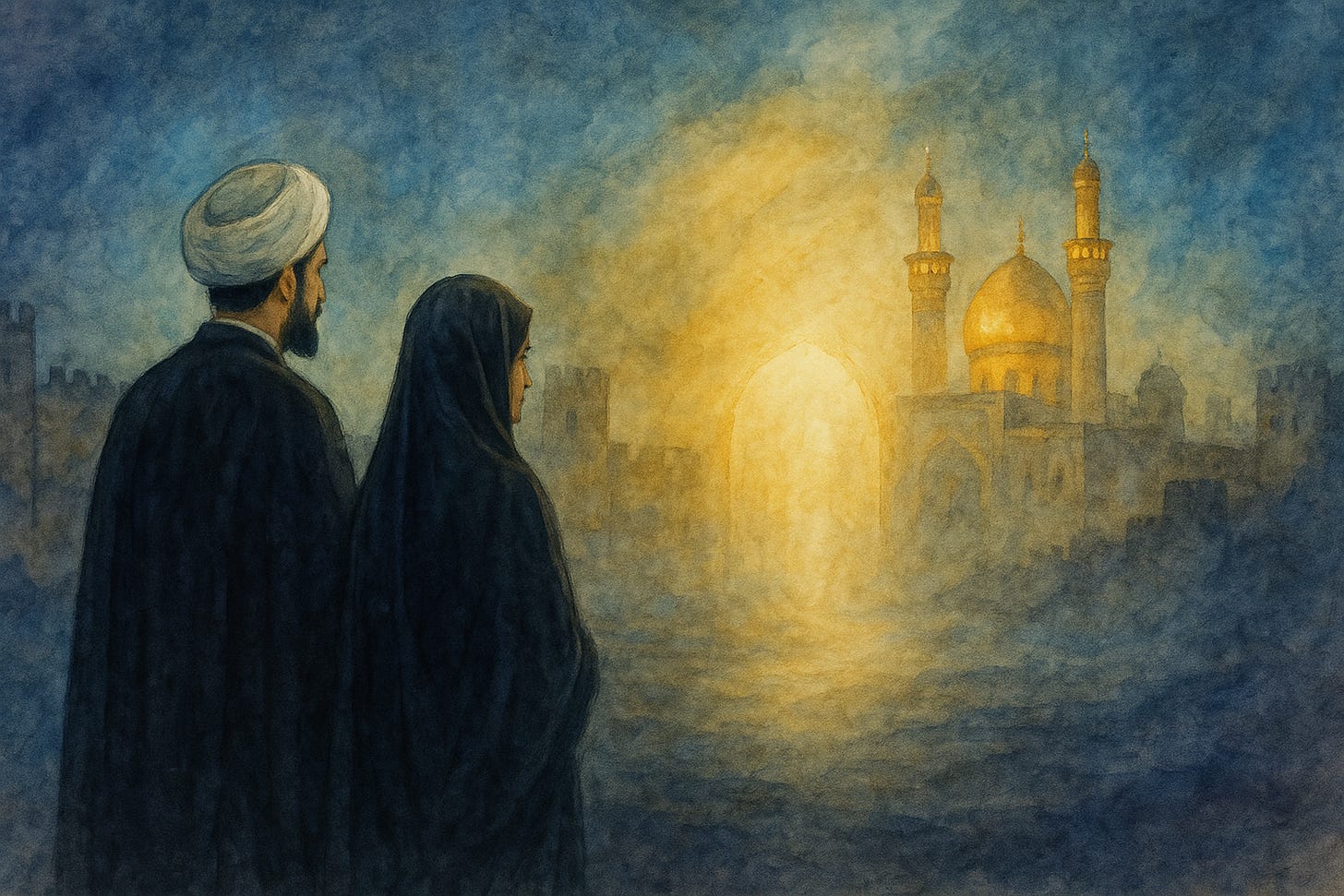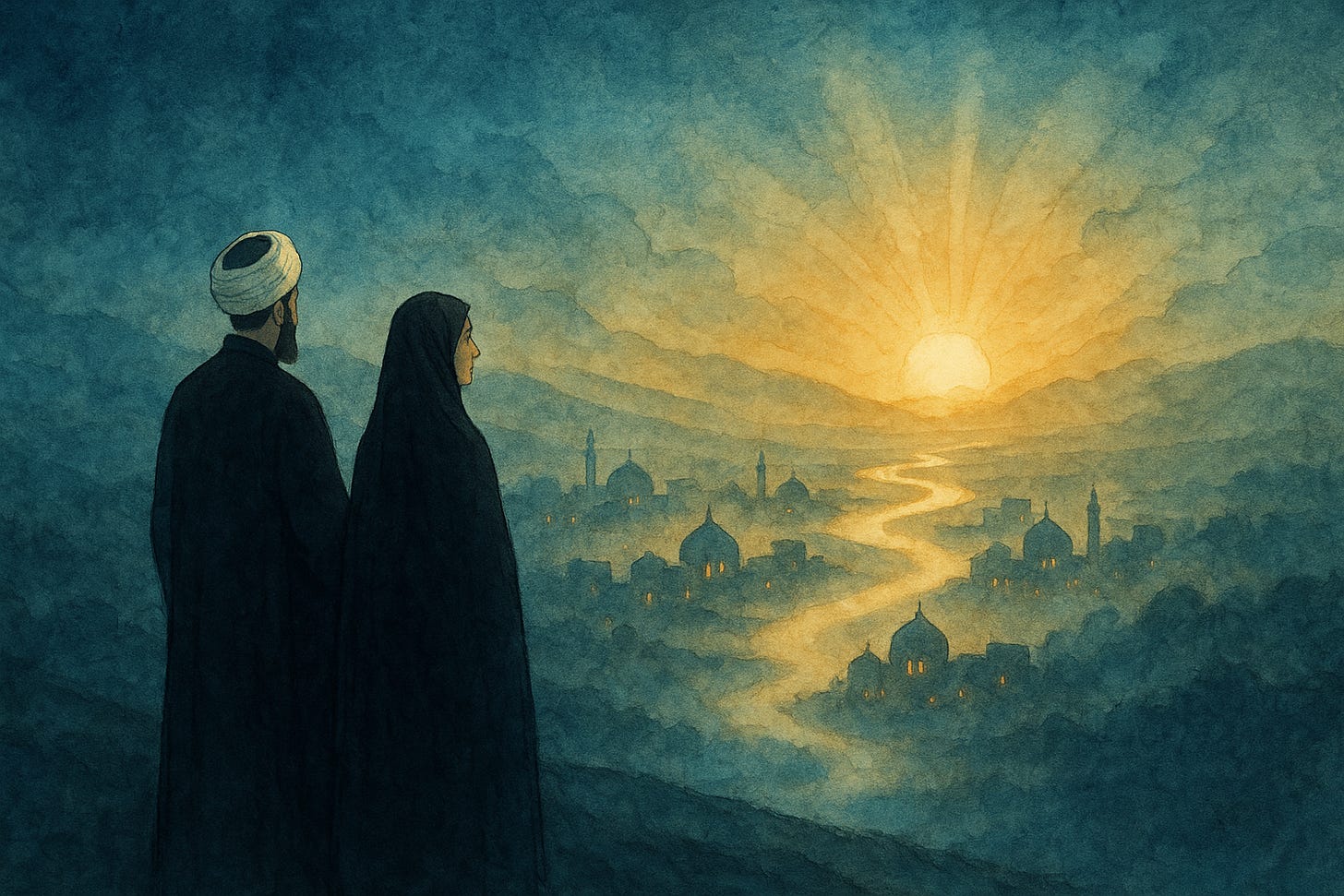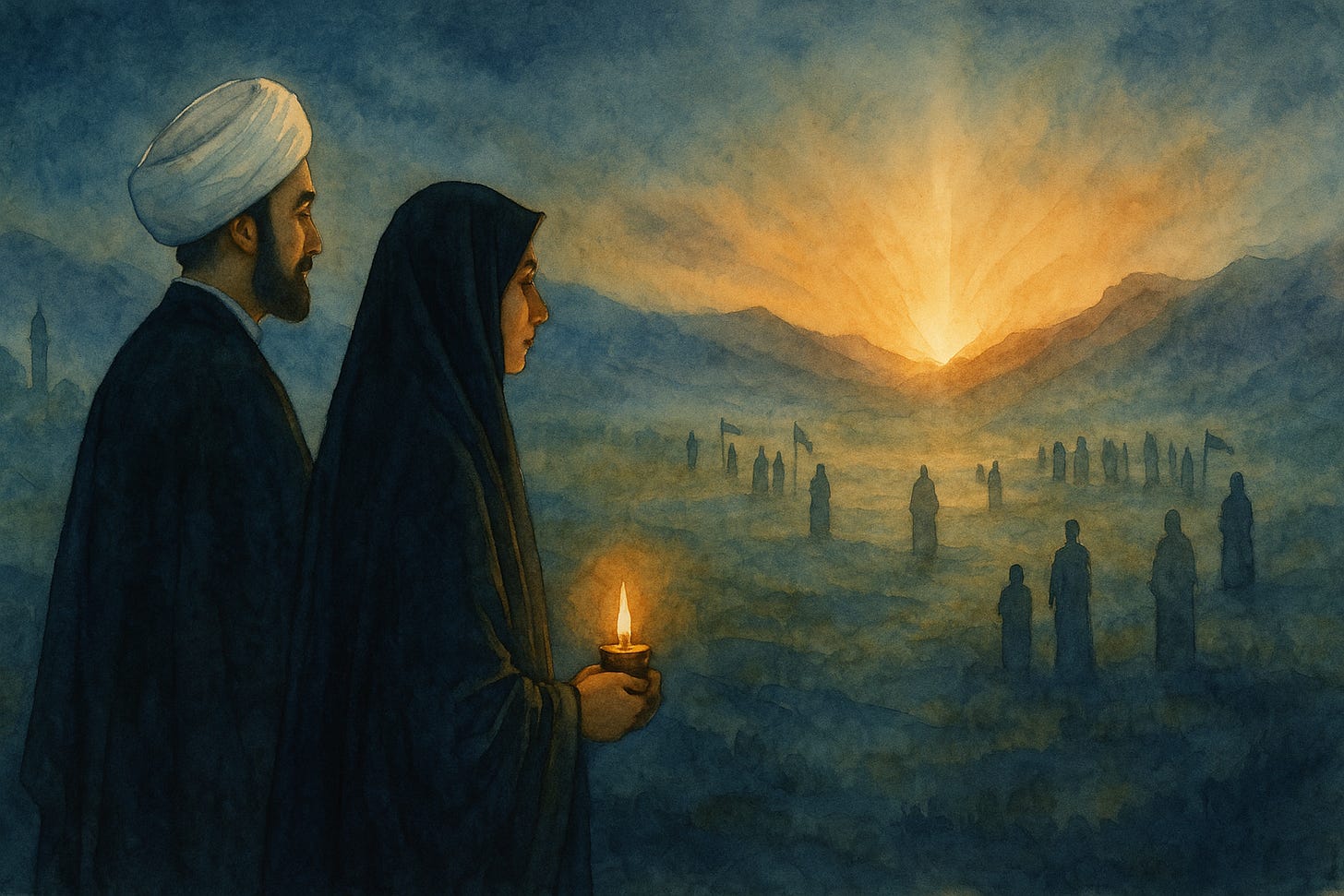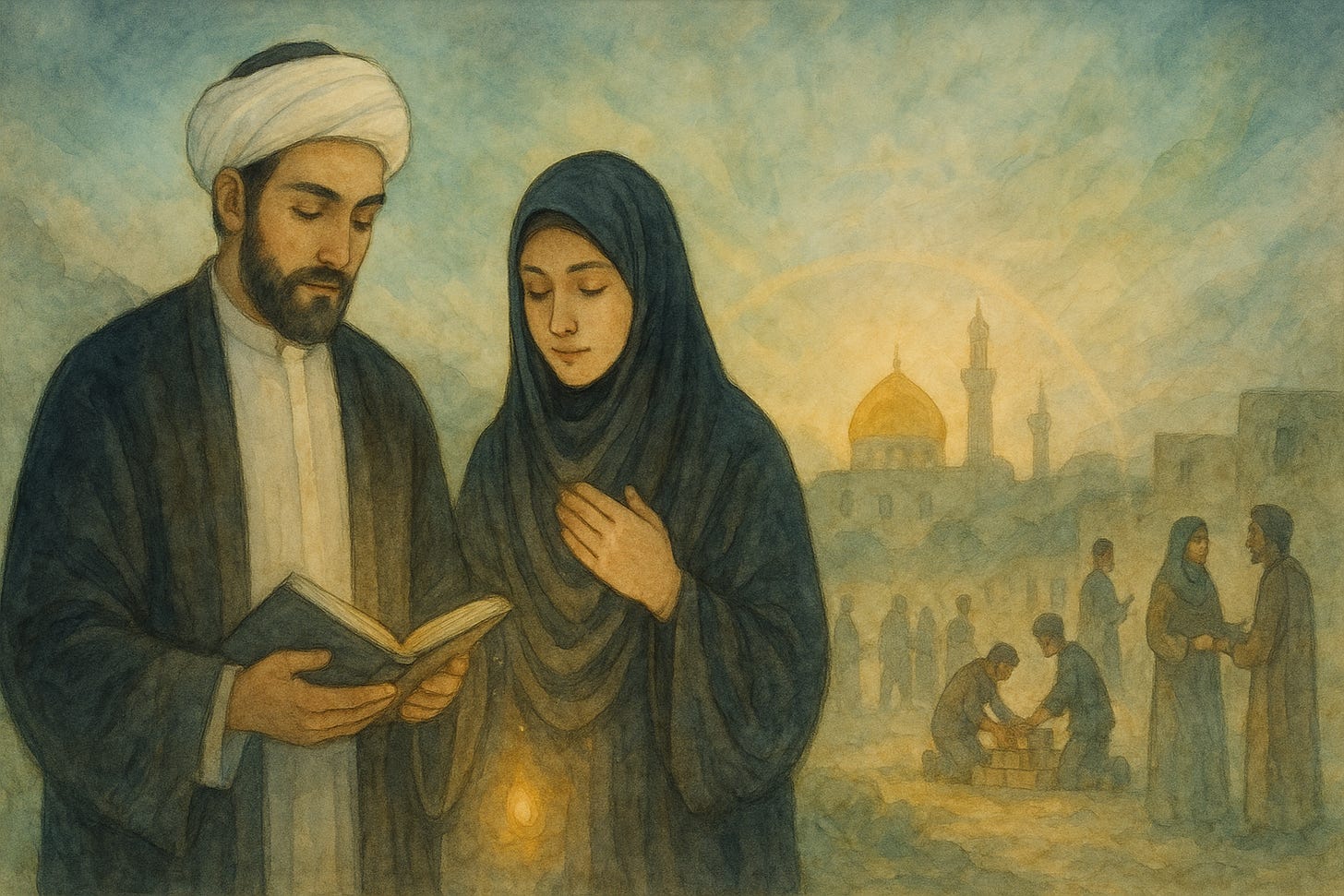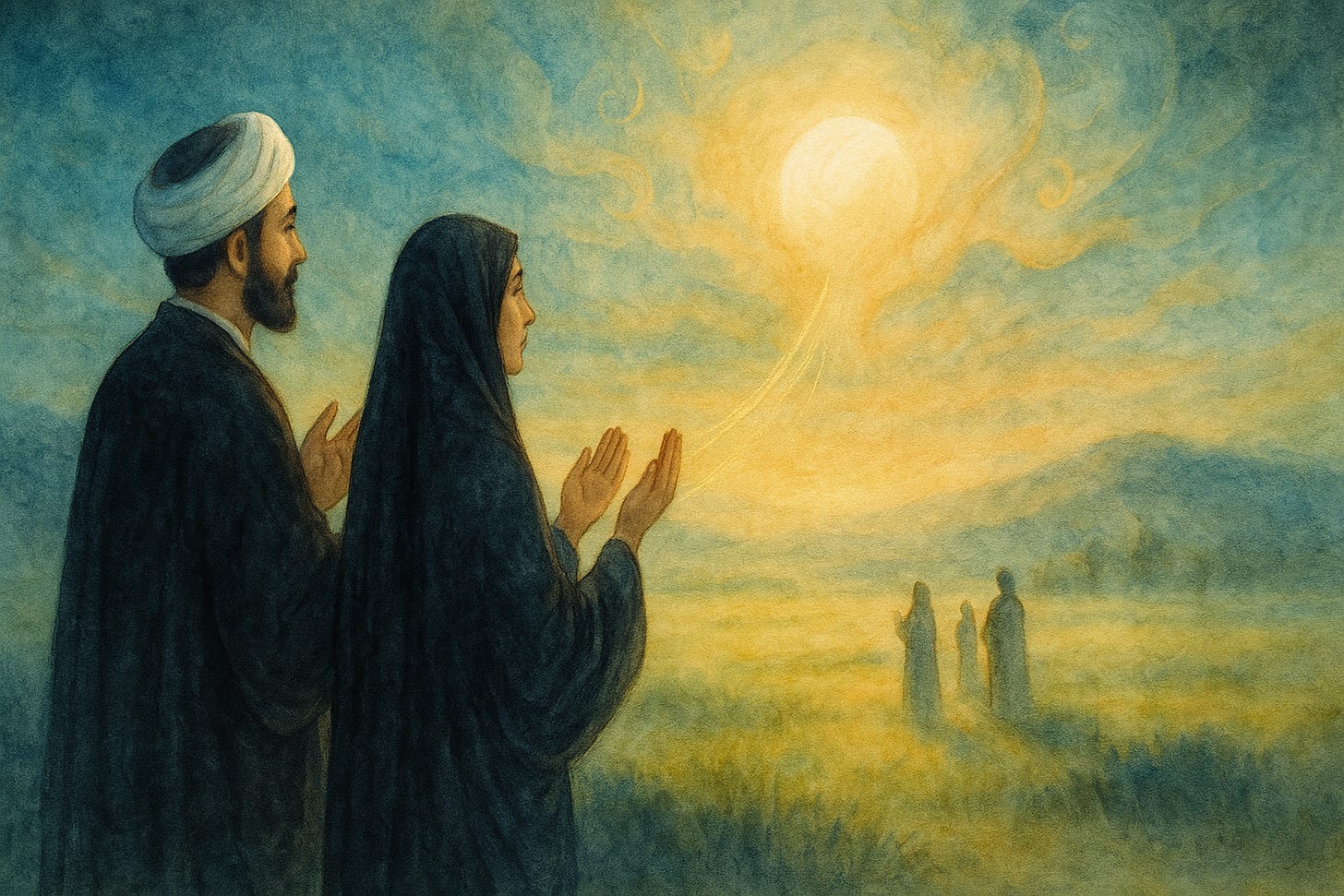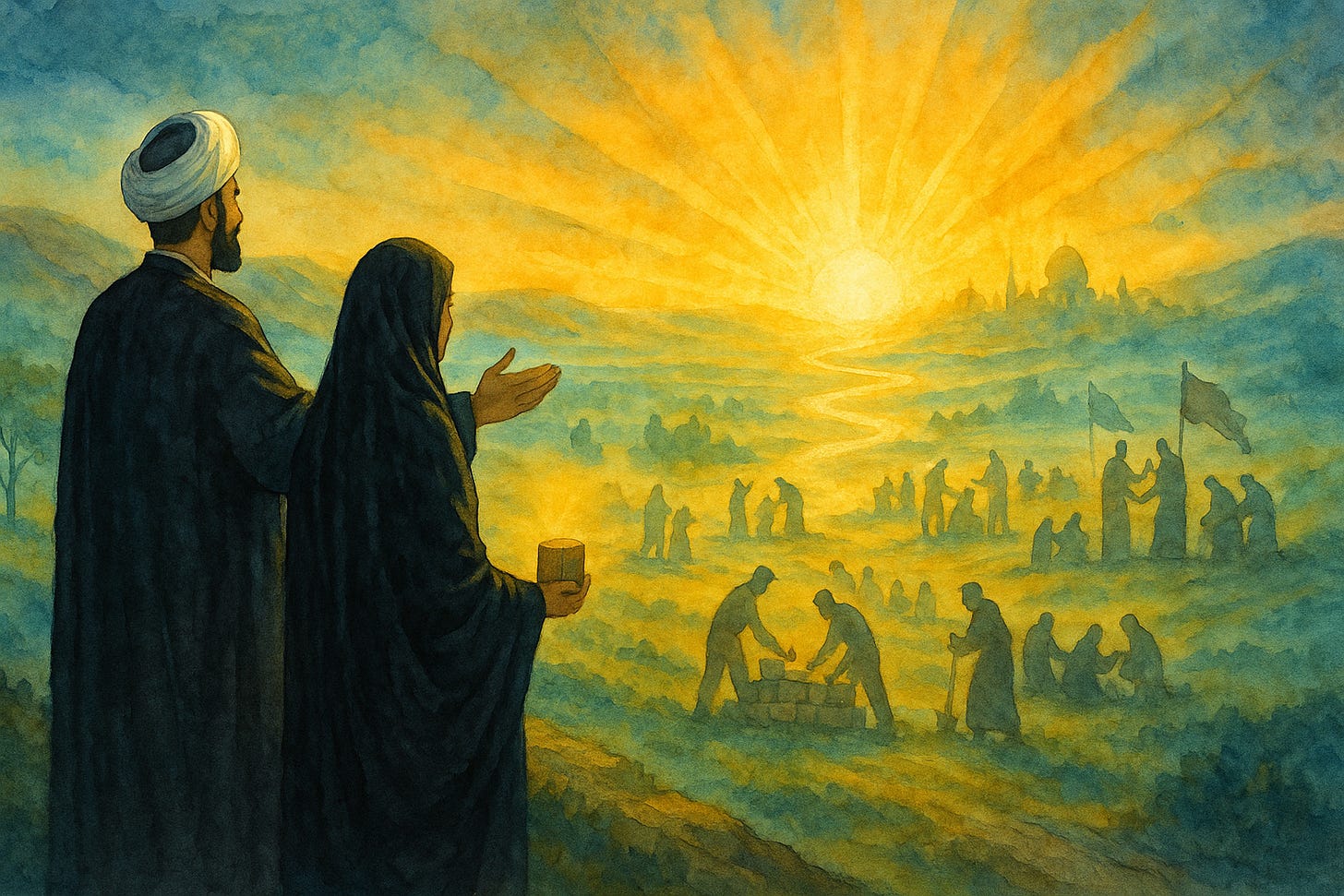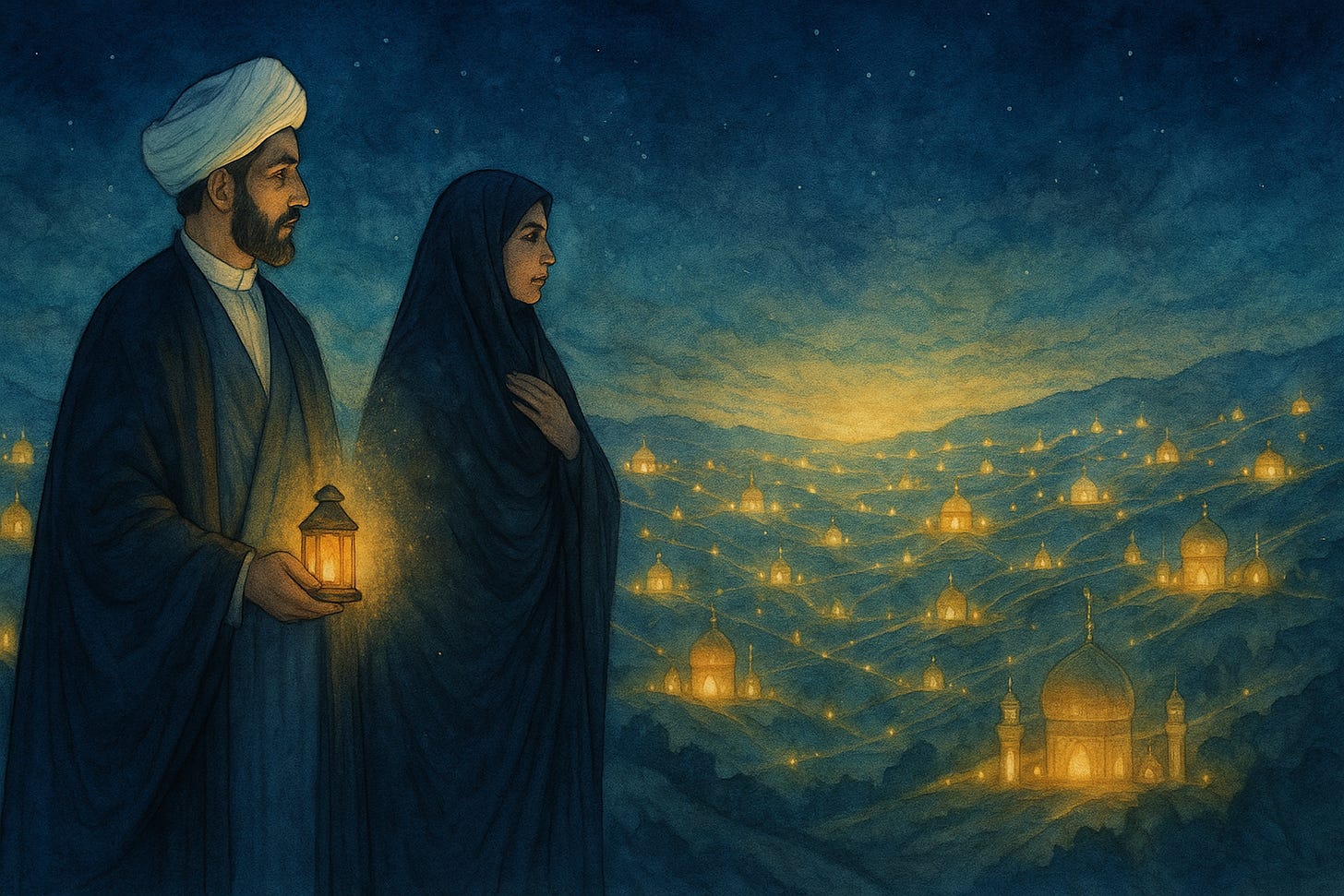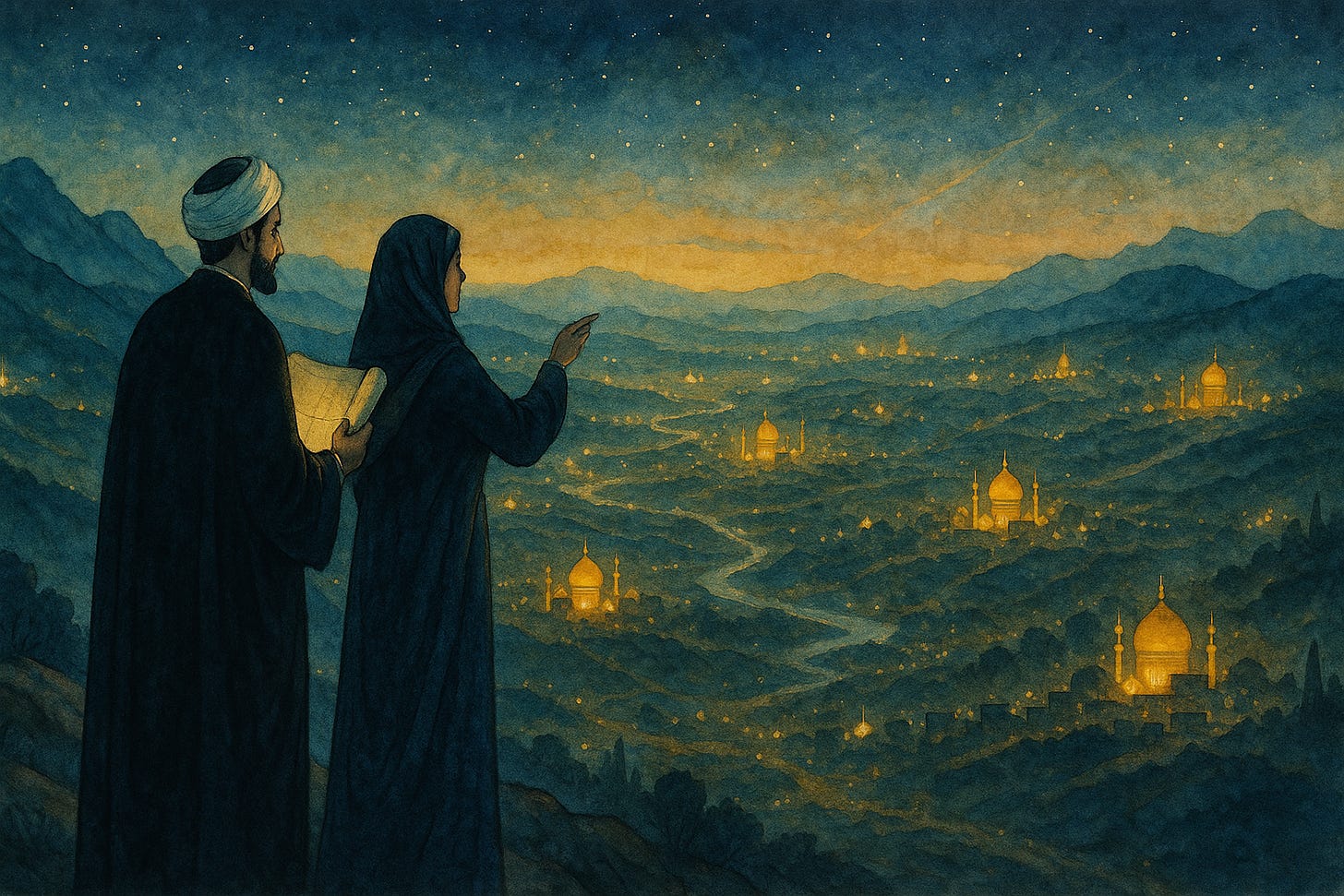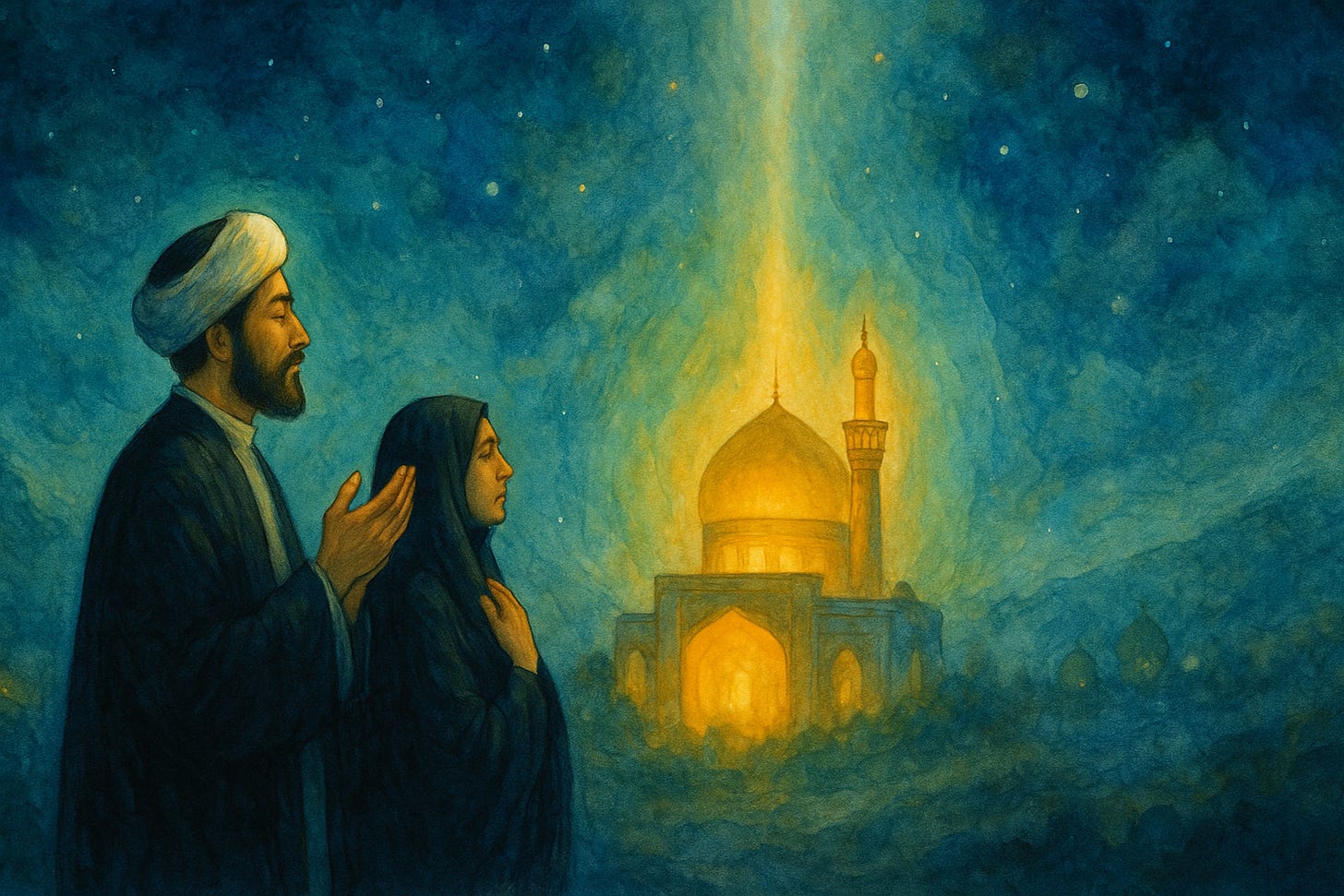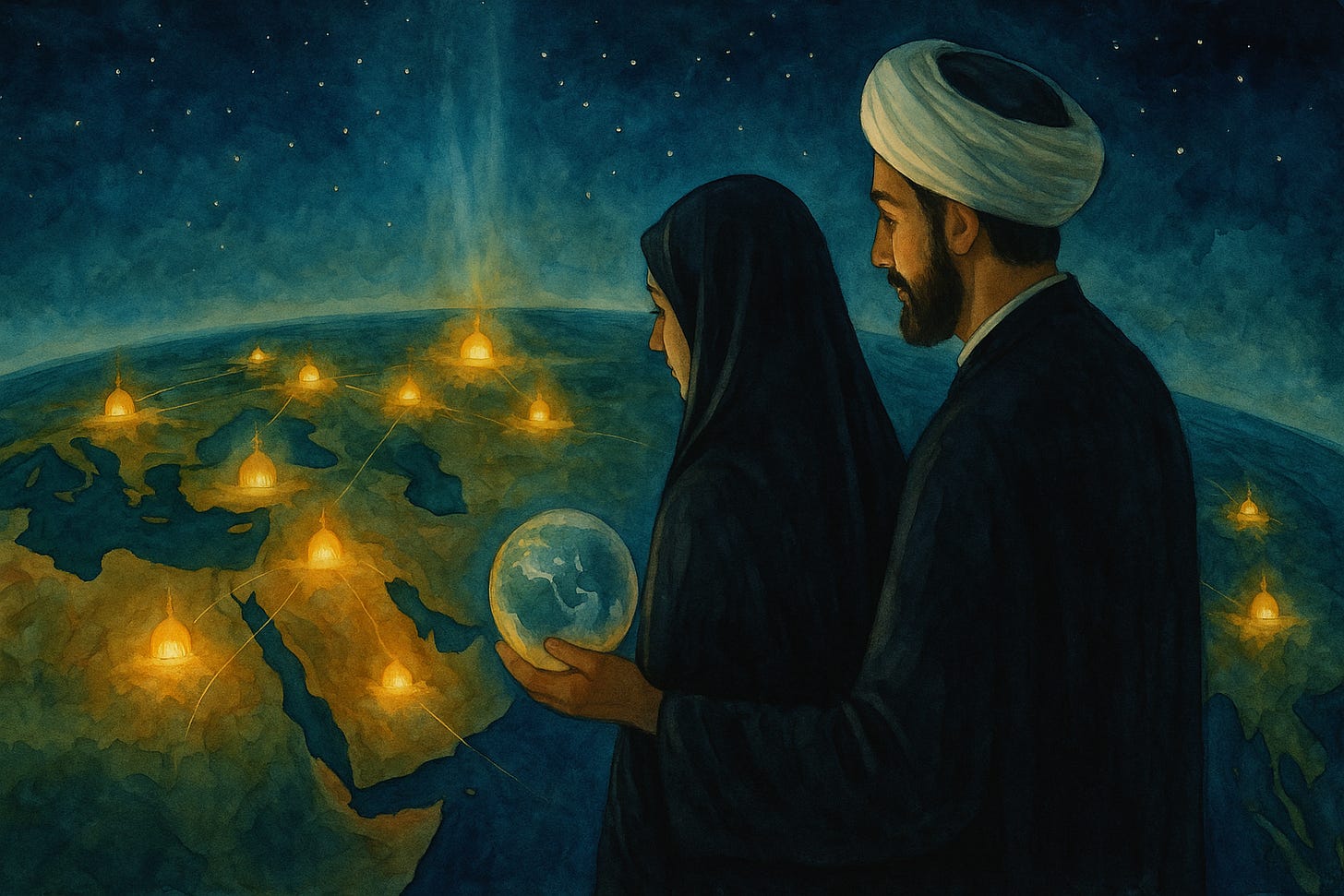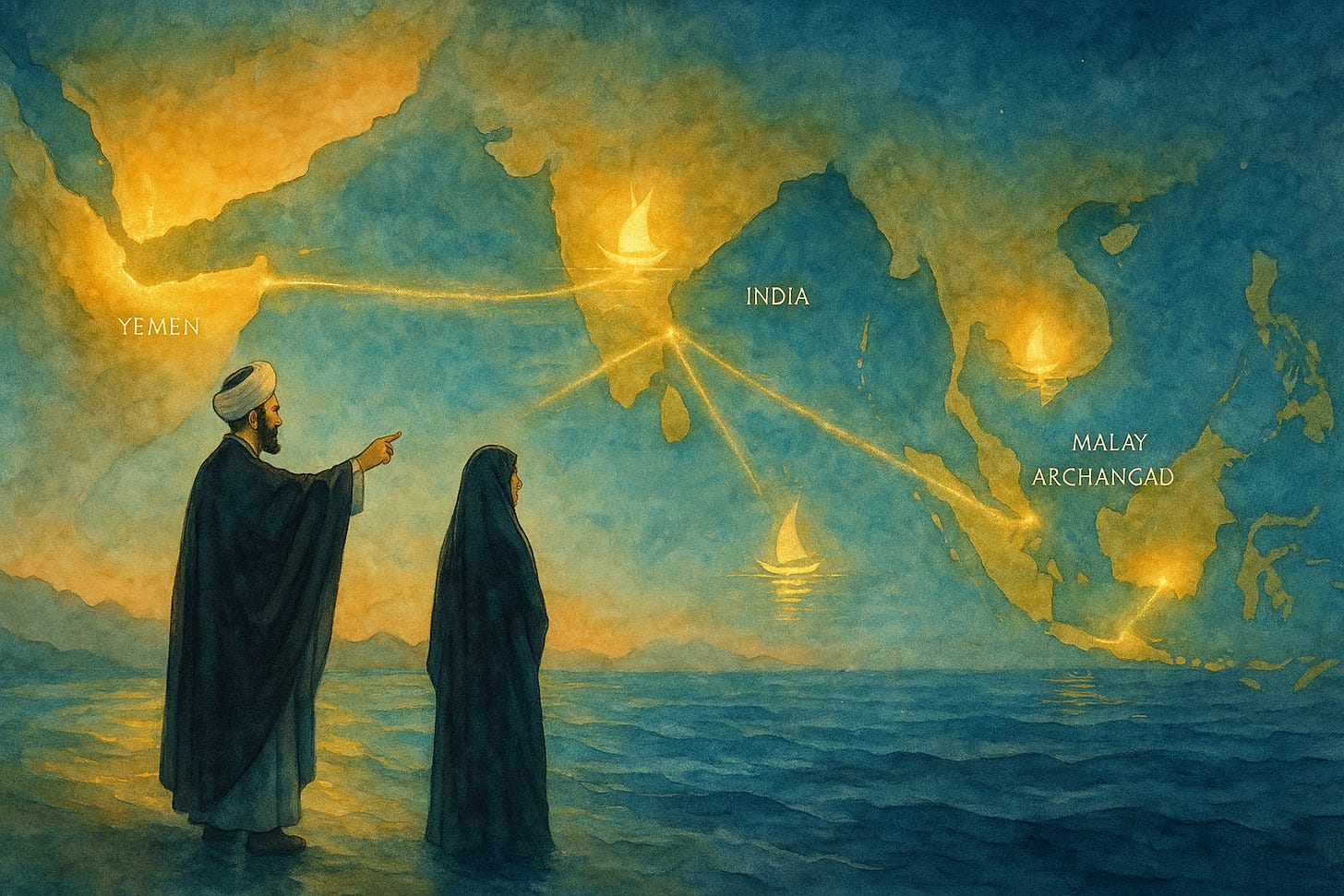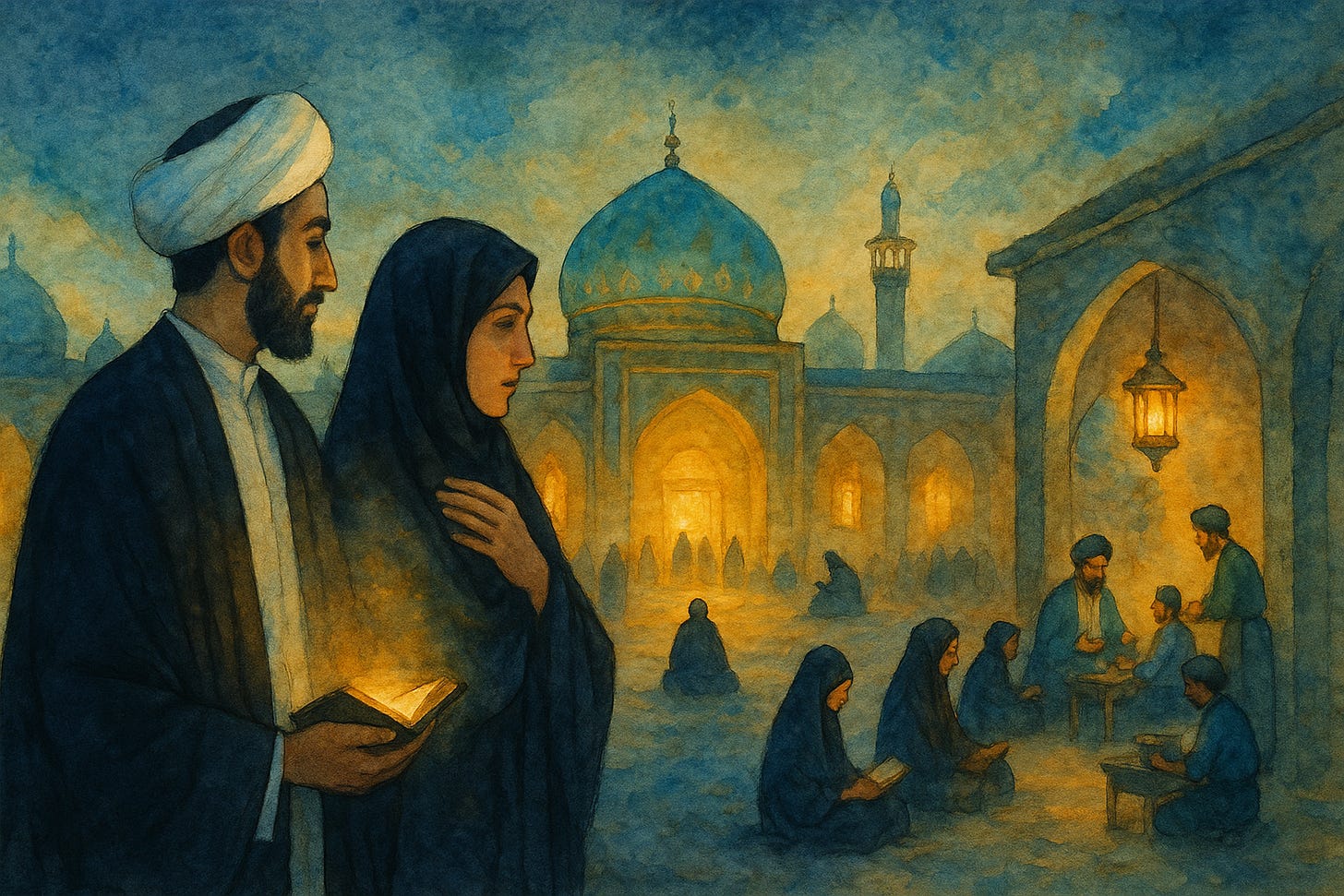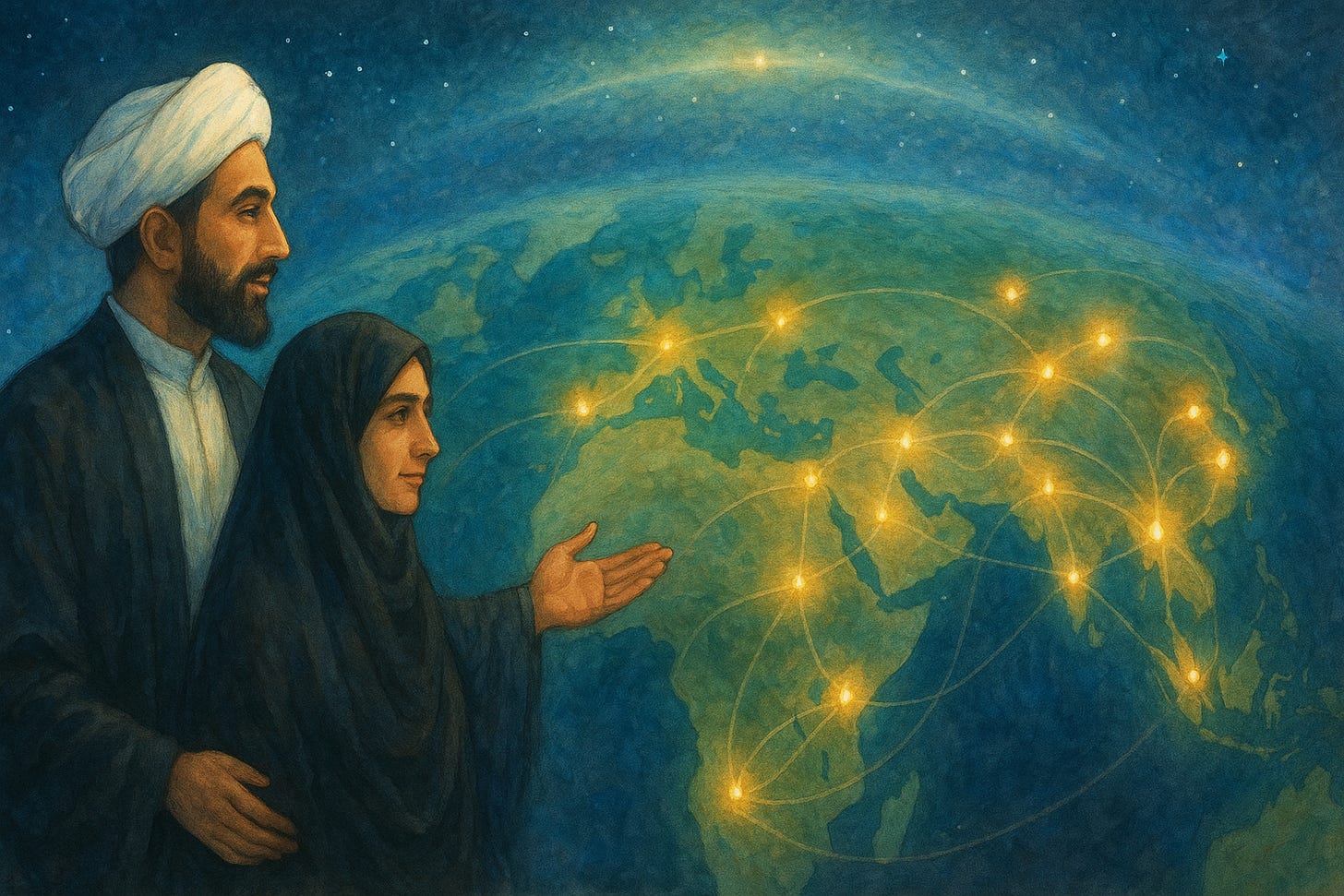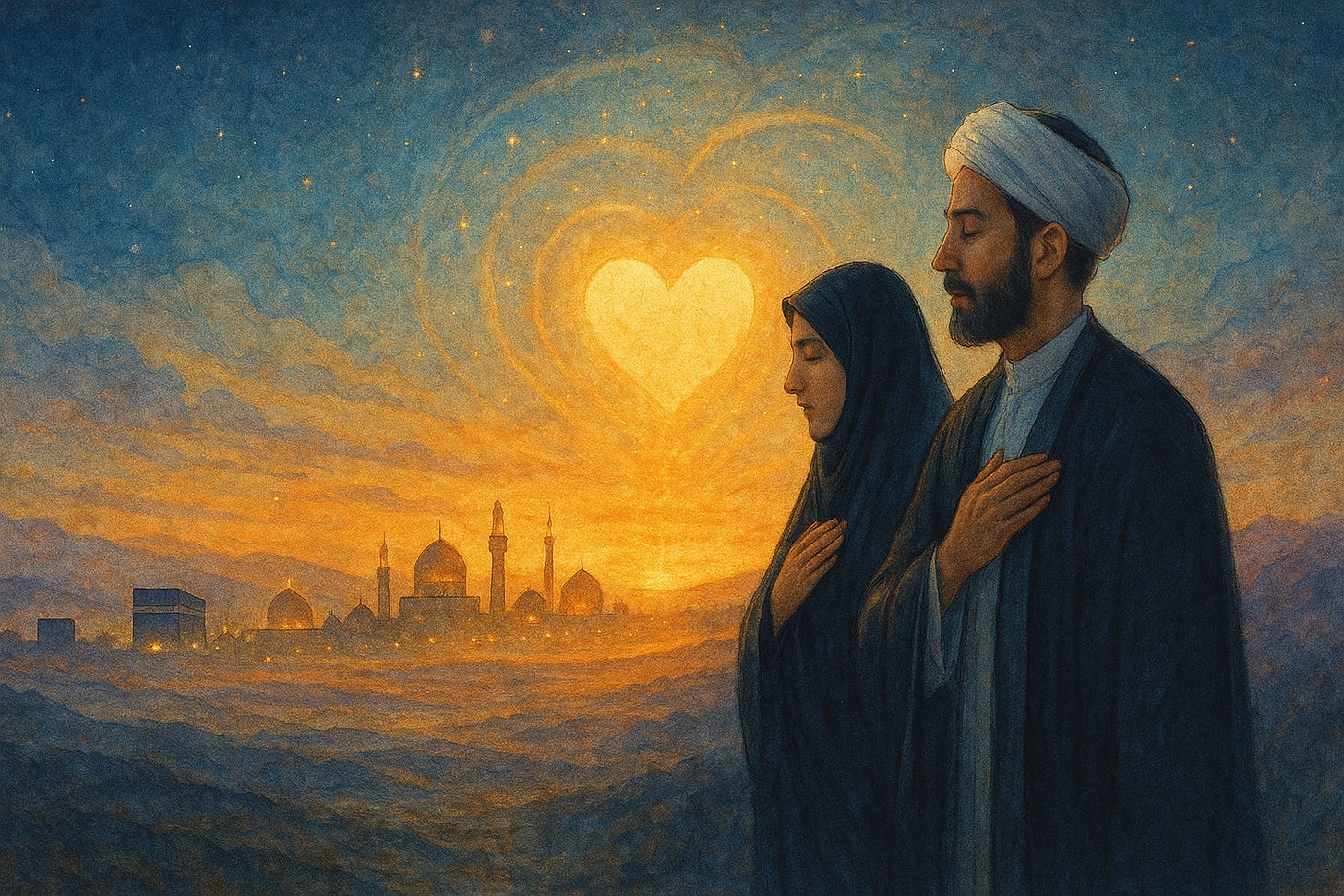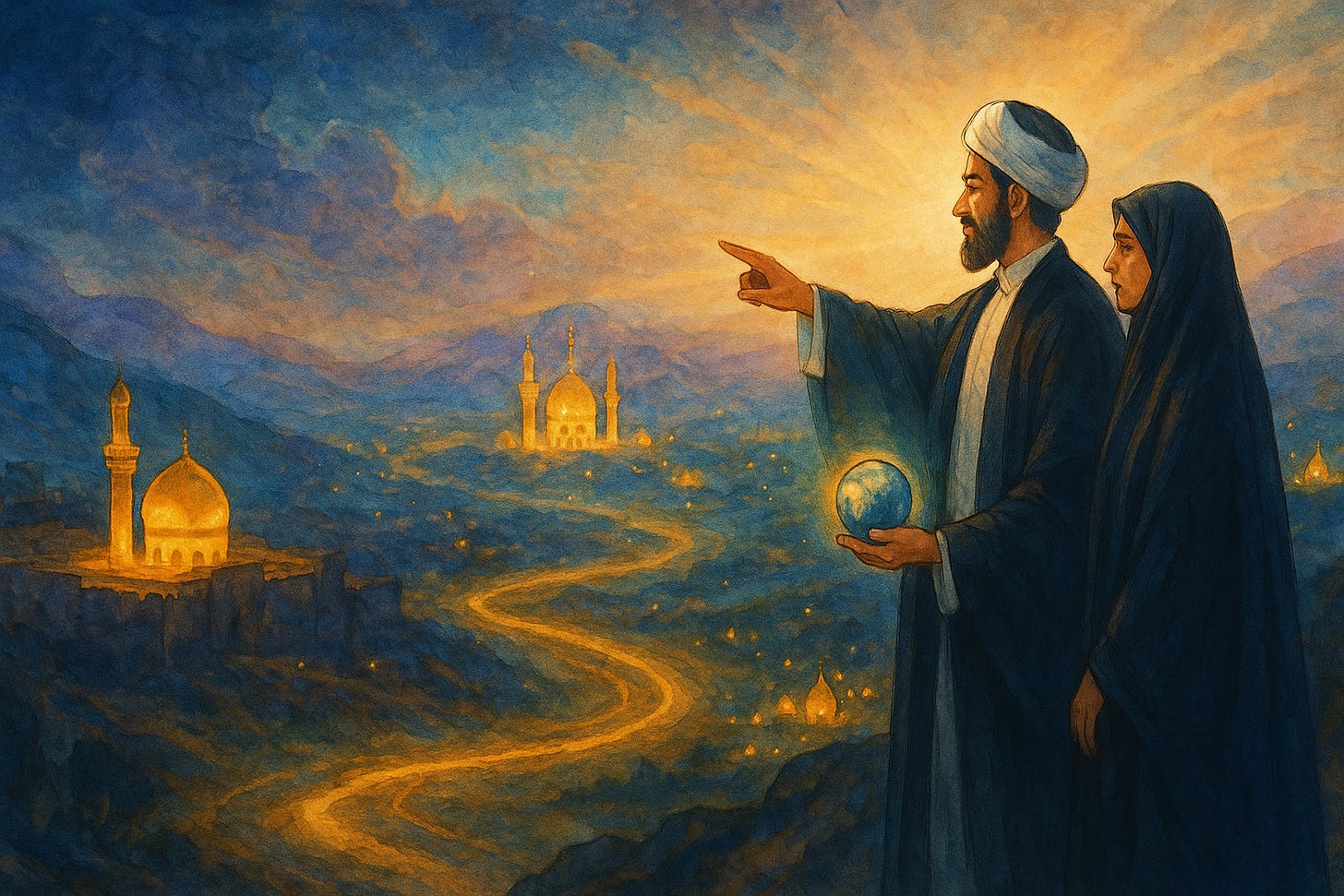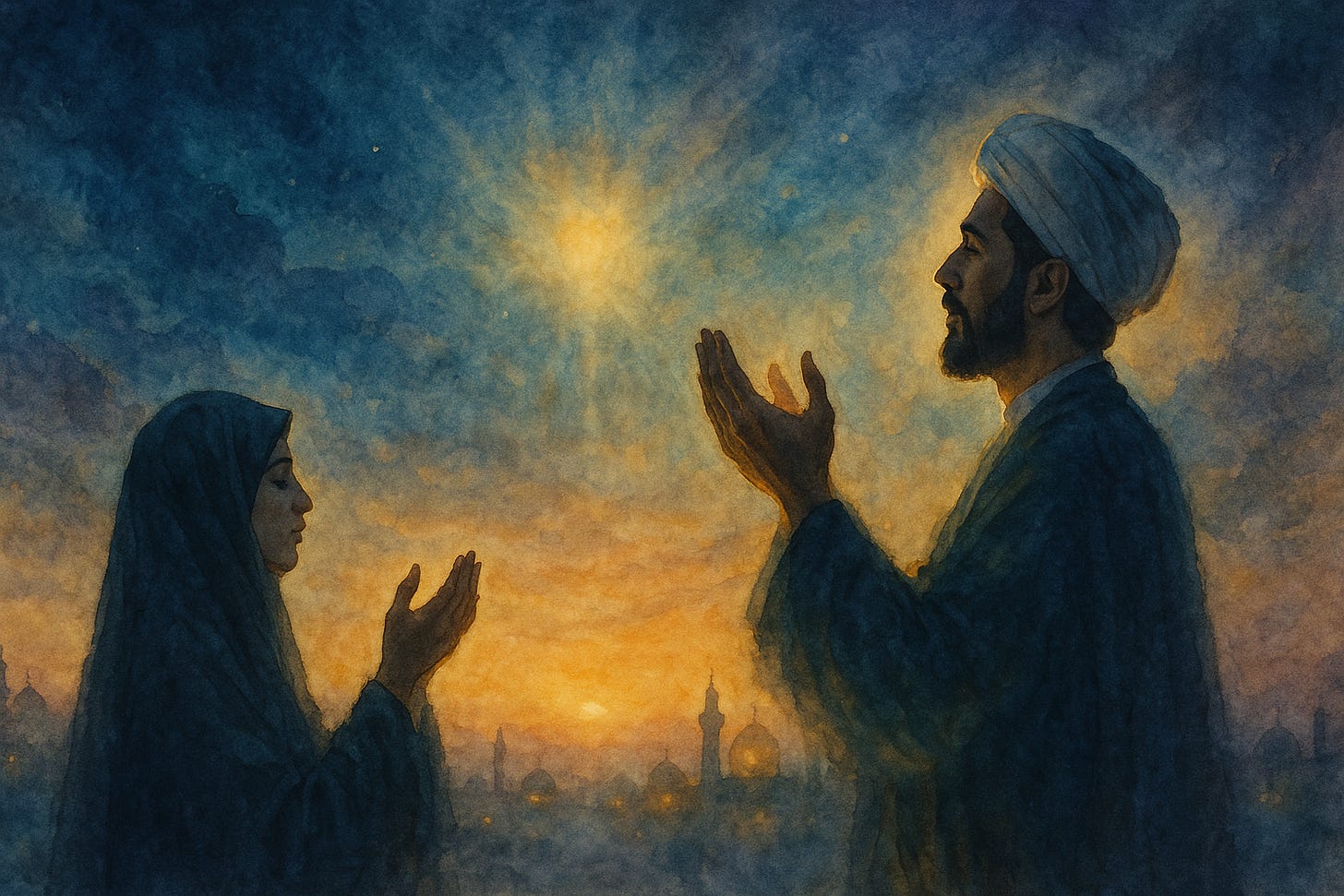[19] The Art of Supplication - The Sacred Windows: The Role of Place - Part 4 - The Prison, The Portal, and The Presence
A series of discussions based on the book Uddat al-Dai wa Najah as-Saee - The Provision of the Supplicant, and the Triumph of the Seeker by Ibn Fahd al-Hilli on the subject of Supplication and Prayer.
In His Name, the Most High
This is the nineteenth part of our series, The Art of Supplication, an ongoing exploration into the sacred relationship between the supplicant, the supplication, and the Divine.
The insights within this series are cumulative, and the nature of our discussion requires that each part build upon foundations laid in the ones that came before.
To prevent misunderstanding and to benefit fully from the depth of this subject, it is essential that you engage with the previous parts in order before continuing with this one.
The previous parts in this series can be found here:
Video of the Majlis (Sermon/Lecture)
This write up is a companion to the video majlis (sermon/lecture) found below:
Audio of the Majlis (Sermon/Lecture)
This write up is a companion to the audio majlis (sermon/lecture) found below:
Recap
The Sanctuary, The Saint, and The Sacrifice
In our last session, our journey through the sacred windows of place continued to the sanctuaries of Iran, where we explored a syllabus for the believer’s heart, learning the lessons of mercy, loyalty, and courage.
Our path began in Mashhad, the Sanctuary of mercy. There, at the threshold of Imam Ali al-Ridha (peace be upon him)—the Guarantor of the Vulnerable (Dhamin al-Ahu) and the ultimate Refuge for every Estranged Soul (Gharib al-Ghuraba)—we learned that the foundation of true strength is an all-encompassing compassion, a rahmah that extends from a vulnerable deer to an entire nation.
We then traveled to Qom, the garden founded upon the loyalty of the Saint, Sayyedah Fatimah al-Ma‘soumeh (peace be upon her). We witnessed how a woman’s unwavering fidelity to her Imam could transform a humble town into a global fortress of knowledge, teaching us that true intercession (shafa’ah) does not negate our duty, but empowers our loyalty.
Finally, we stood in the silent gardens of the martyrs, the places of ultimate Sacrifice. In the presence of the shuhada—the witnesses—we learned the pedagogy of death: that to live without fear, we must connect with those who are truly alive with their Lord, and that our fear of mortality must be replaced by a fear of dishonour.
Together, these sanctuaries have taught us the virtues of the heart: to be merciful, to be loyal, and to be fearless.
But our sacred map is not yet complete.
The story of the Ahl al-Bayt, also takes us to places of immense trial and profound mystery.
What happens when the light of the Imamate is not accessible in a grand shrine, but is confined within the four walls of a prison? And what happens when that light is withdrawn from public view altogether, veiled by the command of God?
Tonight, our journey continues as we seek the answers in the final great sanctuaries of the Imams in Iraq.
We travel first to Kadhimiyyah, the shrine of the “imprisoned light,” where Imam Musa al-Kadhim and his grandson Imam al-Jawad (peace be upon them) teach us the power of patience (sabr) and endurance in the face of absolute tyranny.
From there, we journey to Samarra, the threshold of the unseen. Here, in the city of the final two visible Imams, Imam al-Hadi and Imam al-Askari (peace be upon them), we stand at the birthplace of the Occultation and learn the active, preparatory meaning of waiting (intidhar).
Finally, we will trace how this light, though veiled, was never extinguished, exploring the shrines of the Imamzadehs—the thousands of “dispersed lamps” whose graves have sanctified lands across the globe, ensuring the continuity of Wilayah and providing a local connection to the hidden heart of the Imamate.
In His most beautiful of names, we continue …
The Sacred Windows: The Role of Place: The Prison, The Portal, and The Presence
Kadhimiyyah — The Sanctuary of Imprisoned Light
Our journey now takes us to the final great sanctuaries of the Imams in Iraq, to places that teach the profound lessons of endurance and anticipation. We begin in the golden-domed sanctuary of Kadhimiyyah in Baghdad, the resting place of the seventh Imam, Musa al-Kadhim, and his grandson, the ninth Imam, Muhammad al-Jawad (peace be upon them both).
Kadhimiyyah presents us with a profound paradox: a place defined by imprisonment and martyrdom — a radiant source of spiritual liberation and answered prayers.
It is a school that teaches that a divine light can never truly be confined, and that a prison cell, when inhabited by a Friend of God, becomes a sanctuary.
The School of Yusuf and the Patience of al-Kadhim
The concept of prison as a place of spiritual victory, rather than defeat, is a Qur’anic principle.
It was established by the Prophet Yusuf (peace be upon him), who, when faced with the choice between sin and incarceration, chose the purity of the prison cell, turning his confinement into a testament of his faith:
قَالَ رَبِّ ٱلسِّجْنُ أَحَبُّ إِلَىَّ مِمَّا يَدْعُونَنِىٓ إِلَيْهِ
“He said, ‘My Lord, the prison is more beloved to me than that to which they invite me.’”
— Qur’an, Surah Yusuf (the Chapter of Joseph) #12, Verse 33
Imam Musa’s most famous title is “al-Kadhim”—one who restrains or swallows his anger.
This was not a sign of passivity, but of immense spiritual power, reflecting a divine quality praised by God in the Qur’an as a characteristic of the highest believers (al-muhsinin):
وَٱلْكَـٰظِمِينَ ٱلْغَيْظَ وَٱلْعَافِينَ عَنِ ٱلنَّاسِ ۗ وَٱللَّهُ يُحِبُّ ٱلْمُحْسِنِينَ
“...and those who restrain anger and pardon the people—and God loves the doers of good.”
— Qur’an, Surah Aal-e-Imran (the Chapter of the Family of Imran) #3, Verse 134
The Imam’s resistance was not in the clash of swords, but in the steadfastness of his soul. His jihad was to embody divine ethics in the face of absolute inhumanity.
The ziyarah (visitation prayer) recited at his shrine is a powerful testament to the nature of his holy struggle.
It does not speak of battles or conquests, but of a profound spiritual victory won in the darkness of the dungeons.
The visitor bears witness to his suffering and his steadfastness, saying:
اَلسَّلامُ عَلَىٰ الْمُعَذَّبِ فِي قَعْرِ السُّجُونِ وَظُلَمِ الْمَطَامِيرِ، ذِي السَّاقِ الْمَرْضُوضِ بِحَلَقِ الْقُيُودِ... اَلسَّلامُ عَلَىٰ حَلِيفِ السَّجْدَةِ الطَّوِيلَةِ وَالدُّمُوعِ الْغَزِيرَةِ وَالْمُنَاجَاةِ الْكَثِيرَةِ
“Peace be upon the one who was tormented in the depths of the prisons and the darkness of the dungeons, the one whose leg was bruised by the rings of the chains... Peace be upon the companion of the long prostration, of the abundant tears, and of the frequent intimate prayers.”
— Shaykh Abbas al-Qummi, Mafatih al-Jinan, from the Ziyarah of Imam Musa al-Kadhim
The tyrant believed he could silence the Imam by imprisoning his body, but as the great jurist and arif (gnostic) Ayatullah Bahjat explained, he only succeeded in turning the prison into a prayer niche (mihrab), teaching us that no wall can ever imprison the soul of a believer:
زندان برای اولیای خدا خلوتگاه انس با محبوب است. امام کاظم (ع) زندان را به محراب عبادت تبدیل کرد و به ما آموخت که هیچ دیواری نمیتواند روح مؤمن را به بند بکشد.
“For the friends of God, a prison is a private chamber for intimacy with the Beloved. Imam al-Kadhim transformed the prison into a prayer niche (mihrab) and taught us that no wall can ever imprison the soul of a believer.”
— Ayatullah Muhammad-Taqi Bahjat, from his collected spiritual counsels, Dar Mahzar-e Bahjat, Volume 1, Page 135
The Mirror of the Community: A Test of Allegiance
But the Imam’s imprisonment was not only a testament to his own divine patience; it was also a severe and painful test for the Shia community of his time.
The story of Kadhimiyyah holds up a mirror, forcing us to ask not only:
“What did the tyrant do?”
but also,
“What did the believers do?”
For nearly seven years, the Imam was imprisoned in Baghdad.
At the very same time, a short journey away, thousands of his followers were making the arduous pilgrimage to Karbala to commemorate Ashura and Arbaeen.
This tragic irony, is a wound in our history.
The contemporary scholar Sayyed Hashem al-Haidari holds this mirror up to us with a searing and essential question:
سبع سنوات الامام الكاظم بالسجن اين شيعته؟ كانوا يذهبون مشيا الى كربلاء وحسين الحقيقي في السجن... هذا تاريخنا وكربلاء تشهد على ذلك.
“For seven years, Imam al-Kadhim was in prison. Where were his Shia? They would go on foot to Karbala while their real Husayn was in prison... This is our history, and Karbala bears witness to it.”
— Sayyed Hashem al-Haidari, from his famous lecture, Karbala is a Witness, delivered in Baghdad, November 3, 2014 (Muharram 9, 1439), Baghdad, Iraq
This is not a condemnation of ziyarah or the tears shed for Imam Husayn.
It is a powerful call to ensure our rituals are not an escape from our responsibilities, but the very fuel for them.
It is a reminder that the deepest tragedy was not just the chains placed on the Imam by his enemy, but the collective failure of a community that was busy with the rituals of mourning a martyred Imam while neglecting the duty of allegiance to their living Imam.
A Spiritual Key for the Prisoner
The school of the Ahl al-Bayt does not only diagnose a problem; it provides a remedy. In the face of unjust imprisonment, beyond political action and social solidarity, we are given a powerful spiritual arsenal.
The A’maal (Special Acts of Worship) of Umm Dawood
At the forefront of these is the famous A’maal of Umm Dawood.
The story of this supplication is directly linked to the tyranny of the Abbasids that Imam al-Kadhim would later face.
Umm Dawood was the wet nurse of Imam Ja’far al-Sadiq (peace be upon him).
Her own son, Dawood, was unjustly imprisoned and taken to Iraq by the Abbasid Caliph al-Mansur.
In her grief and desperation, she went to Imam al-Sadiq for help.
The Imam told her to wait for the sacred month of Rajab and to perform a specific set of acts on the 15th day: to fast on the 13th, 14th, and 15th, perform ghusl (ritual bathing) at noon on the 15th, and then offer a series of prayers followed by a long, profound supplication that he taught her.
The great scholar of supplications, Sayyed Ibn Tawus, narrates the outcome:
قالت أم داود: فكتبت الدعاء وانصرفت... فلما كان في الليل، لم أزل أصلي حتى كان آخر الليل... ثم نمت، فإذا أنا برسول الله (ص) ومن معه من الأنبياء والأئمة... يقول: يا أم داود، أبشري... فإن الله تعالى قد أجاب دعاءك، وسيطلق عن ابنك. قالت: فانتبهت فما لبثت إلا قدر مسافة الطريق من العراق، فإذا بداود قد قدم.
Umm Dawood said: “So I wrote down the supplication and left... When night came, I continued praying until the last part of the night... Then I slept, and I saw the Messenger of God and with him the prophets and Imams... He said: ‘O Umm Dawood, rejoice... for God the Exalted has answered your prayer, and your son will be released.’ She said: ‘I awoke, and it was not long after—just the time it takes to travel from Iraq—that Dawood arrived.’”
— Sayyed Ibn Tawus, Iqbal al-A’maal (The Welcoming of Deeds), Volume 3, Page 353
This established the A’maal as a time-tested spiritual remedy. And it is important to clarify that while its most powerful and recommended time is the 15th of Rajab, our great scholars have affirmed that the supplication (dua) itself can be recited at any time of need with the intention of seeking God’s favour.
In addition to this, our tradition is rich with other keys for the prisoner.
The Supplication of Imam Musa al-Kadhim in Prison
This is perhaps the most potent supplication, as it was recited by the Imam of the Prisoners himself.
يَا مُخَلِّصَ الشَّجَرِ مِنْ بَيْنِ رَمْلٍ وَطِينٍ وَمَاءٍ... خَلِّصْنِي مِنْ يَدَيْ هَارُونَ
“O Deliverer of the plant from between the sand, clay, and water!... Deliver me from the hands of Harun.”
— Sayyed Ibn Tawus, Muhaj al-Da’awat wa Manhaj al-’Ibadat, Page 220
The Supplication of Prophet Jonah (Yunus)
The Imams have taught that no believer in distress recites this verse without God granting them relief.
لَّآ إِلَٰهَ إِلَّآ أَنتَ سُبْحَٰنَكَ إِنِّى كُنتُ مِنَ ٱلظَّٰلِمِينَ
“There is no deity except You; exalted are You. Indeed, I have been of the wrongdoers.”
— Qur’an, Surah al-Anbiya (the Chapter of the Prophets) #21, Verse 87
These are not just ancient texts; they have been the lifelines for the heroes of our own era. From the dungeons of the Shah to the solitary confinement cells of Zionist prisons, the steadfastness of believers like Shaykh Abdul Karim Obeyed, and Hajj Mustafa Dirani was nurtured by this very spiritual connection, which turns the prison from a tool of the oppressor into a site of spiritual ascension (mi’raj).
Finally, there is a profound supplication for moments when all material doors seem closed. This supplication (dua), attributed to the great gnostic Sayyed Ali Qadhi Tabatabai, has been recently and repeatedly emphasised by both Imam Khamenei and Sayyed Hassan Nasrallah as a source of immense power in the face of seemingly insurmountable difficulties.
It is a key for the impossible:
اللَّهُمَّ يَا مَنْ إِذَا تَضَايَقَتِ الْأُمُورُ فَتَحَ لَهَا بَابًا لَمْ تَذْهَبْ إِلَيْهِ الْأَوْهَامُ، فَصَلِّ عَلَى مُحَمَّدٍ وَآلِ مُحَمَّدٍ وَافْتَحْ لِأُمُورِيَ الْمُتَضَايِقَةِ بَابًا لَا يَذْهَبُ إِلَيْهِ وَهْمٌ يَا رَبَّ الْعَالَمِينَ
“O God, O You who, when matters become constricted, opens a door for them that imaginations cannot even conceive of! Send Your blessings upon Muhammad and the family of Muhammad, and for my own constricted matters, open a door that no imagination can conceive of, O Lord of the worlds.”
— A supplication attributed to the great mystic (arif) and scholar, Sayyed Ali Qadhi Tabatabai
This supplication is the ultimate expression of trust in God’s limitless power to create a way where there seems to be no way, a perfect spiritual weapon for every believer facing the prisons of our time.
Calls to Clarify: Lessons from the Imprisoned Light
Clarify Your Power: The Victory of the Cell over the Palace
Kadhimiyyah teaches us that true power is spiritual endurance, not worldly authority.
The tyrant Harun al-Rashid is a footnote remembered for his cruelty.
The imprisoned Imam, with nothing but his prayer mat, conquered history and continues to rule over the hearts of millions.
This principle—that steadfastness (sumud) in captivity is itself a form of victory—is a cornerstone of the modern school of resistance.
The martyred leader of the Islamic Resistance in Lebanon, Sayyed Hassan Nasrallah has affirmed this, explaining that the prisoner achieves victory from within the cell itself:
عندما يصمد الأسير في سجنه ولا ينكسر ولا يعطي العدو ما يريده من معلومات أو تنازلات، فهذا بحد ذاته انتصار كبير. هو يحقق النصر من داخل الزنزانة.
“When the prisoner is steadfast (samid) in his prison and does not break, and does not give the enemy the information or concessions that it wants, then this in itself is a great victory. He achieves victory from within the prison cell.”
— Sayyed Hassan Nasrallah, from a speech marking Prisoner and Wounded Fighter Day, Beirut, Lebanon, February 2013
Clarify Your Devotion: From Ritual to Allegiance
The painful history of Imam al-Kadhim’s imprisonment forces us to clarify the nature of our devotion.
We must ask ourselves: are our rituals—our ziyarah, our mourning, our tears—connected to our allegiance to the Husayn of our own time?
Or are they a substitute for it?
This lesson calls us to ensure that our love for the past Imams translates into active, costly loyalty to the cause of the Imam of our Age.
Clarify Your Prison: The Mihrab (prayer-niche) in the Prison of the Self
The lesson of the imprisoned Imam forces us to clarify the nature of our own, self-imposed prisons.
Many of us are prisoners of our fears, our bad habits, our greed, or our desire for social approval.
The lesson of Kadhimiyyah is to transform these personal prisons into sanctuaries of remembrance.
We can turn our solitude into a dialogue with God and our struggles against our ego into a form of jihad, emulating the Imam who turned his dungeon into a prayer niche.
Clarify Your Solidarity: From Feeling to Action
To truly be a follower of Imam al-Kadhim is to feel the pain of every unjustly imprisoned person.
Our ziyarah to him is incomplete if we do not remember the prisoners of conscience in our own time, from the forgotten scholars in despotic regimes to the thousands of Palestinians languishing in Zionist dungeons.
We must clarify that our solidarity is not just a passive feeling of sympathy, but an active spiritual duty.
We can revive the tradition of performing the A’maal of Umm Dawood, and regularly recite the profound supplications taught by the Imams—especially the dua of Imam al-Kadhim from his own cell—dedicating the immense power of these prayers to the freedom of all the unjustly imprisoned.
Samarra — The Portal to the Unseen
From the defiant patience of the prison cell in Kadhimiyyah, our journey now takes us to Samarra, the city that became both a fortress and a cage for the final visible Imams of the Ahl al-Bayt.
It was here, in a garrison city built by the Abbasids to control their own military, that the tenth Imam, Ali al-Hadi, and the eleventh Imam, Hasan al-Askari (peace be upon them both), were held under intense house arrest.
Their shared title, “al-Askarayn” (the two in the military camp), testifies to the reality of their lives.
Samarra is the sanctuary of the besieged Imamate, and more profoundly, it is the portal—the great threshold where the era of manifest, physically accessible leadership transitioned into the era of the Occultation (ghaybah).
The Theology of Concealment
The veiling of God’s Proof is not an accident of history, but a part of the Divine Plan, foreseen in the Qur’an itself.
The Imams (peace be upon them) explained that the continuity of guidance, even when the guide is hidden, is alluded to in Surah Saba:
وَجَعَلْنَا بَيْنَهُمْ وَبَيْنَ الْقُرَى الَّتِي بَارَكْنَا فِيهَا قُرًى ظَاهِرَةً
“And We placed between them and the cities which We had blessed, [other] cities apparent.”
— Qur’an, Surah Saba (the Chapter of Sheba) #34, Verse 18
In his seminal early tafsir (exegesis), Shaykh Ali ibn Ibrahim al-Qummi records a profound esoteric interpretation of this verse from Imam Muhammad al-Baqir (peace be upon him). The Imam explained the verse’s inner meaning:
القُرَى الَّتِي بَارَكْنَا فِيهَا هُمْ أَئِمَّةُ أَهْلِ الْبَيْتِ (ع)، وَالْقُرَى الظَّاهِرَةُ هُمُ الْحُجَجُ مِنْهُمْ، يَكُونُونَ ظَاهِرِينَ فِي بَعْضِ الْأَزْمَانِ، وَيَغِيبُونَ فِي بَعْضِهَا
“The ‘cities which We had blessed’ are the Imams of the Ahl al-Bayt (peace be upon them). And the ‘cities apparent’ are the Proofs (hujaj) from among them, who are manifest in some eras, and are hidden in others.”
— Shaykh Ali ibn Ibrahim al-Qummi, Tafsir al-Qummi, Volume 2, Page 201, Commentary on Surah Saba (34), Verse 18
Imam al-Baqir (peace be upon him) explained that the “cities which We had blessed” are the Ahl al-Bayt, and the “cities apparent” are the continuous chain of hujaj (proofs) from them.
Some of these proofs are manifest, and some are hidden.
This verse sets a divine precedent for the continuity of guidance, even when the guide is concealed from public view.
The Occultation was not a rupture, but a divinely ordained transition. It was in Samarra, under the watchful eyes of the Abbasid state, that this transition was born.
Here, in the most controlled environment imaginable, the twelfth Imam, al-Mahdi (may God hasten his return), was born in secret, a miracle of hope in an age of despair, before he was veiled from the world by God’s command.
The School of Intidhar (Active Waiting)
The beginning of the Occultation in Samarra inaugurated a new spiritual practice for the Shia community: intidhar al-faraj (waiting for the relief).
This is not a passive, helpless waiting; it is one of the highest forms of worship.
The Prophet Muhammad (peace be upon him and his family) declared:
أَفْضَلُ أَعْمَالِ أُمَّتِي انْتِظَارُ الْفَرَجِ
“The best of the actions of my Ummah is waiting for the relief.”
— Shaykh al-Saduq, Kamal al-Din wa Tamam al-Ni’mah, Volume 2, Chapter 55, Page 644, Hadeeth 6
This waiting is rooted in the absolute necessity of the Imam. His physical presence or absence does not change his status, as the hujjah (proof) of God and the axis of existence.
This is why the Prophet gave his famous, solemn warning:
مَنْ مَاتَ وَلَمْ يَعْرِفْ إِمَامَ زَمَانِهِ مَاتَ مِيتَةً جَاهِلِيَّةً
“Whoever dies without knowing the Imam of his time, dies the death of the age of ignorance (jahiliyyah).”
— Al-Kulayni, Al-Kafi, Volume 1, Kitab al-Hujjah (The Book of Proofs), Page 377, Hadeeth 3
Our duty, then, is to know him and to wait for him.
But what is the nature of this waiting?
The great martyr and philosopher Ayatullah Murtadha Mutahhari made a crucial distinction between two kinds of intidhar:
انتظار سازنده و انتظار ویرانگر. انتظار ویرانگر آن است که بگوییم دنیا باید پر از ظلم شود تا امام بیاید، پس ما ساکت مینشینیم. اما انتظار سازنده، انتظاری است که انسان را به اصلاح خود و جامعه وا میدارد تا زمینه را برای ظهور فراهم کند.
“There is a constructive waiting and a destructive waiting. Destructive waiting is that which says the world must be filled with injustice for the Imam to come, so we will sit silently. But constructive waiting is the waiting that compels a person to reform himself and his society in order to prepare the ground for the Reappearance.”
— Ayatullah Murtadha Mutahhari, from his book Qiyam wa Enqelab-e Mahdi (The Uprising and Revolution of Mahdi)
This “constructive waiting” is the very essence of the revolutionary spirit.
Imam Khomeini, the architect of the modern embodiment of this principle, taught that waiting for the Imam means actively fighting against the very injustices he will come to uproot:
ما منتظران باید در تجهیز خود و دیگران برای فراهم کردن زمینه ظهور آن حضرت کوشش کنیم. انتظار فرج، انتظار قدرت اسلام است و ما باید در راه تحقق آن تلاش کنیم.
“We who are waiting must strive to equip ourselves and others to prepare the ground for his reappearance. Waiting for the relief is waiting for the power of Islam, and we must work to bring about its realization.”
— Imam Ruhollah Khomeini, Sahifeh-ye Imam, Volume 21, Page 14, from a speech delivered on the 15th of Sha’baan, 1980
This active preparation begins with the self. The great arif (gnostic) and faqih (jurist) Ayatullah Bahjat emphasised that true intidhar (waiting) is an internal, spiritual struggle for purification:
انتظار فرج، بالاترین مرتبه تسلیم و بندگی است. منتظر واقعی کسی است که خود را برای سربازی امام زمان (عج) آماده میکند و این آمادگی، جز با تهذیب نفس و تقوا حاصل نمیشود
“Waiting for the relief is the highest station of submission and servitude. The true waiter is the one who prepares himself to be a soldier for the Imam of the Time, and this readiness cannot be achieved except through self-purification (tahdhib al-nafs) and piety (taqwa).”
— Ayatullah Muhammad-Taqi Bahjat, from his collected spiritual counsels, Dar Mahzar-e Bahjat, Volume 2, Page 298
This internal purity must then manifest externally as a commitment to social justice. The late Ayatullah Sayyed Muhammad Husayn Fadhlullah connected intidhar directly to our global responsibilities:
الانتظار ليس حالة سلبية، بل هو حالة حركة إيجابية في خط العدل ضد الظلم. المنتظر هو الذي يعيش هموم المستضعفين في كل مكان، ويعمل من أجل رفع الظلم عنهم.
“Waiting is not a negative state; it is a positive state of movement in the line of justice against injustice. The one who waits is the one who lives the concerns of the oppressed everywhere and works to lift the injustice from them.”
— Ayatullah Sayyed Muhammad Husayn Fadhlullah, from his Friday Sermon on the 15th of Sha’baan, delivered at the Imamayn al-Hassanayn Mosque, Beirut, Lebanon, October 27, 2000
Ultimately, this constructive, self-purifying, and justice-seeking waiting finds its most complete expression in the school of resistance.
Sayyed Hassan Nasrallah has repeatedly taught that steadfastly resisting the global arrogance and its projects in the region is the highest and most practical form of intidhar (waiting) today:
إن مقاومتنا وصمودنا في وجه المشروع الصهيوني والأمريكي هو بحد ذاته من أفضل مصاديق انتظار الفرج. نحن نمهد الطريق للإمام (عج) بإيجاد جيل مقاوم لا يقبل بالذل والهوان.
“Our resistance and our steadfastness in the face of the Zionist and American project is, in itself, one of the best manifestations of waiting for the relief. We are paving the way for the Imam by creating a generation of resistance that does not accept humiliation and disgrace.”
— Sayyed Hassan Nasrallah, from a televised speech on Al-Manar, commemorating the birth of Imam al-Mahdi, May 22, 2016
Calls to Clarify: Lessons from the Portal to the Unseen
Clarify the Meaning of Waiting: From Passivity to Preparation
Samarra teaches us to clarify our understanding of intidhar (waiting).
It is not a passive hope that things will get better on their own.
It is an active and revolutionary state of preparation.
As Shaykh Alireza Panahian teaches, intidhar is the ultimate framework for personal and social action:
انتظار، استراتژیکترین و قویترین شکل خودسازی و جامعهسازی است.
“Waiting (intidhar) is the most strategic and powerful form of self-building and community-building.”
— Shaykh Alireza Panahian, from his book Intizar ‘Aamiyaneh, ‘Alemaneh, ‘Arefaneh (A Common, Scholarly, and Gnostic Waiting), Page 12
This means we must be purifying our souls, strengthening our families, building just communities, and standing against the tyrants of our time, so that when the Imam does return, he finds soldiers and servants, not mere spectators.
Clarify Our Connection: The Unbroken Bond
The Occultation does not mean the Imam is absent or unaware.
He is the veiled sun, whose light and warmth still reach the earth. We must clarify that our connection to him is real and unbroken.
This connection is maintained through sincere supplication, moving between the heart-felt cry of yearning and the direct address of love.
We cry out with the words of Dua al-Nudba:
أَيْنَ بَقِيَّةُ اللَّهِ؟
“Where is the Remnant of God?”
— Shaykh Abbas al-Qummi, Mafatih al-Jinan, Dua al-Nudba (The Supplication of Lamentation)
And we address him directly with the beautiful salutation from Ziyarat Aal-e-Yaseen:
اَلسَّلامُ عَلَيْكَ يَا حُجَّةَ اللَّهِ وَدَلِيلَ إِرادَتِهِ
“Peace be upon you, O Proof of God and the guide to His will.”
— Shaykh Abbas al-Qummi, Mafatih al-Jinan, Ziyarat Aal-e-Yaseen
The connection is also strengthened by giving charity on his behalf and by making our every action an offering to him, and above all by actively waiting, but working to hasten his return, and being ready for when he returns.
As the mystics say, we work to make the proverbial sun rise in the West.
Clarify Our Goal: Paving the Way for His Government
The ultimate purpose of our waiting is not just personal salvation; it is to prepare for the establishment of his divine global government.
This clarifies our ultimate political and social goal.
Every act of justice we perform, every effort to fight corruption in ourselves, our homes, our families, our communities, our villages, towns and cities, our countries, and every move to defend the oppressed is a small act of paving the way for his return and his rule.
Our waiting is a constant struggle (jihad) to make ourselves, and our small corner of the world, worthy of the justice he will bring.
The Presence — The Dispersed Lamps of Wilayah
Our journey through the sacred windows of place began in the great central sanctuaries and has now led us to the thresholds of concealment in Kadhimiyyah and Samarra.
This raises a crucial two-part question for the era of the Imam’s Occultation.
First, how does his authoritative guidance continue?
The Imams themselves answered this, directing us to the righteous jurists (al-fuqaha al-’udul)—the maraji’ and the Wali al-Faqih—as their general deputies and our guides in matters of law and society.
Second, beyond legal guidance, how does the tangible blessing (barakah) and felt spiritual presence of the Ahl al-Bayt remain accessible to believers scattered across the globe?
The answer to this second question comes in two beautiful parts.
The first lies in the thousands of shrines of the Imamzadehs—the noble descendants of the Imams. These are the “dispersed lamps,” the living proof of a sacred geography that was never meant to be confined but was destined to expand.
This is the journey we will complete in this session.
The second part of the answer, which will be the topic of our final session, is even more intimate. It lies in the divine potential vested in our own local spaces: our mosques, our community centres, and our very homes, which we are called to transform into sanctuaries ourselves.
But first, let us explore the great network of the dispersed lamps.
A Geography of Light: The Sanctuaries of the Imamzadehs
Before we explore these sites, it’s important to understand the term Imamzadeh (امامزاده) itself.
The word Imamzadeh (امامزاده) is a Persian compound word — Imam (امام) and Zadeh (زاده) — meaning “born of” or “descendant of.”
Thus, an Imamzadeh is a descendant—a child, grandchild, or later progeny—of one of the Shia Imams
Over time, the term has come to refer not only to the holy person but also to the shrine or mausoleum that houses their remains.
While there is no single Arabic equivalent, the shrine is often called a maqam (station) or marqad (resting place) of the Ahl al-Bayt, and the descendants themselves are known as Sadaat (Sayyeds).
The dispersion of the Prophet’s descendants was a tragedy born of intense persecution by the Umayyad and Abbasid caliphs.
The Alawites (descendants of Imam Ali) were forced to migrate, seeking refuge in the farthest corners of the Muslim world—from the mountains of Daylam in Iran to the valleys of Yemen, from the cities of Syria to the plains of Central Asia and North Africa.
But what the tyrants intended as an act of erasure, God transformed into an act of plantation.
Wherever these noble souls settled, taught, or were martyred, their very presence sanctified the land, and their graves became seeds from which new communities of faith would grow.
This reality is a beautiful manifestation of God’s promise in the Qur’an:
سَنُرِيهِمْ ءَايَـٰتِنَا فِى ٱلْـَٔافَاقِ وَفِىٓ أَنفُسِهِمْ حَتَّىٰ يَتَبَيَّنَ لَهُمْ أَنَّهُ ٱلْحَقُّ
“We will show them Our signs on the horizons and within themselves until it becomes clear to them that it is the truth.”
— Qur’an, Surah al-Fussilat (the Chapter of the Detailed Explanations) #41, Verse 53
The shrines of the Imamzadehs are these very “signs on the horizons.” The Ahl al-Bayt themselves established the profound spiritual status of these sites.
When a man from Rey came to the tenth Imam, Ali al-Hadi (peace be upon him), and said he had just returned from the ziyarah of Imam Husayn, the Imam gave him this incredible guidance:
أَمَا إِنَّكَ لَوْ زُرْتَ قَبْرَ عَبْدِ الْعَظِيمِ عِنْدَكُمْ لَكُنْتَ كَمَنْ زَارَ الْحُسَيْنَ بْنَ عَلِيٍّ (ع)
“Know that if you had visited the grave of Abd al-Azim in your own land, you would be like one who has visited Husayn ibn Ali (peace be upon him).”
— Shaykh al-Saduq, Thawab al-A’maal wa ‘Iqab al-A’maal, Page 99, Hadeeth 2
This hadith about Shah Abd al-Azim al-Hasani in Rey (near modern-day Tehran) establishes a vital principle: God, in His mercy, has provided local points of access to the immense grace of the major shrines for those who cannot reach them.
Windows to the Unseen: The Spiritual Function of the Shrines
These shrines are not mere historical monuments; they are active spiritual conduits, “windows to the unseen.”
Each one is a local embassy of the Imamate, offering a tangible point for tawassul (seeking a connection) and a place where prayers are answered.
Ayatullah Bahjat, explained this spiritual reality:
هر یک از این امامزادگان، دریچهای به سوی عالم غیب و وسیلهای برای توجه به امام زمان (عج) هستند. زیارت آنها، تجدید عهد با خط ولایت است.
“Each one of these Imamzadehs is a window to the unseen world and a means of turning one’s attention to the Imam of the Time. Visiting them is a renewal of one’s covenant with the line of Wilayah.”
— Ayatullah Muhammad-Taqi Bahjat, from his collected spiritual counsels, Dar Mahzar-e Bahjat, Volume 1, Page 188
This reality is felt palpably at the thousands of shrines scattered across the globe.
Each one is a testament not merely to a flight from persecution, but to an honourable resistance enacted through migration itself.
In leaving their homes, the descendants of the Ahl al-Bayt refused to grant legitimacy to the tyrants, and wherever they settled, they continued their sacred mission—educating, guiding, and planting the seeds of true faith in new lands.
The Shrines of the Imamzadehs
Among the most well known and revered shrines of the Imamzadehs are:
Sayyedah Zaynab bint Ali (Damascus, Syria): The heroic daughter of Imam Ali, whose courage after the tragedy of Karbala saved the Imamate. Her shrine is a global centre for the lovers of the Ahl al-Bayt and a symbol of resistance.
Sayyedah Ruqayyah bint al-Husayn (Damascus, Syria): The young daughter of Imam Husayn, who was martyred as a child in the prison of Yazid. Her small, powerful shrine is a testament to the suffering of the children of Karbala.
Shah Abd al-Azim al-Hasani (Rey, Iran): A noble descendant of Imam Hasan al-Mujtaba who fled Abbasid persecution and died in hiding. Imam al-Hadi declared that visiting his grave carries the same reward as visiting the grave of Imam Husayn.
Ahmad ibn Musa al-Kadhim, ‘Shah Cheragh’ (Shiraz, Iran): The son of the 7th Imam and brother of Imam al-Ridha. He was journeying to join his brother in Khorasan when he and his entourage were ambushed and martyred by Abbasid agents. His name means “King of the Light.”
Imamzadeh Saleh (Tajrish, Tehran, Iran): A son of the 7th Imam, Musa al-Kadhim (peace be upon him), and therefore a brother of Imam al-Ridha. He migrated to the region of Rey to escape Abbasid persecution and was martyred in the area of Tajrish, where his luminous shrine is now a major centre of pilgrimage in Iran’s capital.
Imamzadeh Davood (Kan, North of Tehran, Iran): A revered descendant of Imam Hasan al-Mujtaba (peace be upon him). According to historical accounts, he fled the persecution of the Abbasids with his companions and sought refuge in the Alborz mountains north of Rey (modern Tehran). He was martyred there, and his shrine, located in a remote mountain valley, has been a major site of pilgrimage for centuries. The difficult journey to reach his shrine was historically seen as an act of great devotion.
Sayyedah Nafisa (Cairo, Egypt): A renowned scholar and ascetic, a descendant of Imam Hasan. She migrated to Egypt, where her piety and knowledge were so revered that her shrine in Cairo is a place of pilgrimage for both Shia and Sunni Muslims to this day.
The sons of Muslim ibn Aqil (Musayyeb, Iraq): Muhammad and Ibrahim, the young sons of Imam Husayn’s envoy to Kufa. They escaped from prison after Karbala but were martyred for the bounty on their heads. Their story is one of the most heart-rending episodes of the post-Ashura tragedy.
Yahya ibn Zayd (Sar-e Pol, Afghanistan): The grandson of Imam Zayn al-Abedin. Following the path of his grandfather Zayd, he led an uprising against the tyranny of the Umayyads and was martyred. His shrine is a major centre of pilgrimage in Afghanistan.
Qutham ibn Abbas, ‘Shah-i-Zinda’ (Samarkand, Uzbekistan): While not an Imamzadeh, he was the cousin of the Prophet Muhammad and Imam Ali. He brought Islam to Central Asia and was martyred there. His magnificent shrine complex, the “Tomb of the Living King,” shows the vast reach of the Prophet’s family.
Abdullah Shah Ghazi (Karachi, Pakistan): A descendant of Imam Hasan al-Mujtaba. He was martyred in Sindh in the 8th century after being pursued by Abbasid agents. His shrine, overlooking the Arabian Sea, is a sanctuary for people of all backgrounds in Karachi.
Bibi Pak Daman, ‘The Chaste Ladies’ (Lahore, Pakistan): This revered shrine is held to be the resting place of several ladies of the Ahl al-Bayt, including Sayyeda Ruqayyah, a daughter of Imam Ali, who fled after the tragedy of Karbala.
Moulay Idriss I (Moulay Idriss Zerhoun, Morocco): A great-great-grandson of Imam Hasan who fled the Abbasids after the Battle of Fakhkh. He established the Idrisid dynasty and is considered the founder of the state of Morocco. His shrine is a foundational site for the nation.
Imam al-Hadi ila’l-Haqq (Sa’dah, Yemen): A descendant of Imam Hasan al-Mujtaba, Yahya ibn al-Husayn is the foundational figure of the Zaydi Imamate in Yemen, a dynasty of the Prophet’s descendants that ruled for over 1,000 years. His shrine in Sa’dah is one of the most important historical and religious sites in Yemen.
The Hadhrami Sayyeds: From Yemen to the Far East
The dispersion of the Ahl al-Bayt’s barakah (blessings) also took other forms, particularly in Yemen, which became a great sanctuary for the Prophet’s descendants.
A powerful historical parallel exists: around the same time that Imam al-Hadi ila’l-Haqq was establishing a state of justice in northern Yemen, another great descendant of the Prophet, Ahmad al-Muhajir, was migrating to southern Yemen to escape persecution.
This Ahmad al-Muhajir was a direct descendant of Imam Ja’far al-Sadiq (peace be upon him). He emigrated from Iraq to the Hadhramaut region of Yemen, establishing a safe haven for his family.
Centuries later, his descendants—now known as the Hadhrami Sayyeds—began a second wave of migration, not fleeing persecution, but carrying the message of Islam as merchant-scholars.
They travelled the Indian Ocean trade routes, settling in:
The Malay Archipelago (modern-day Indonesia, Malaysia, Singapore)
The coasts of India (especially the Malabar and Gujarat coasts)
East Africa (the Swahili coast)
These Hadhrami Sayyeds were instrumental in peacefully spreading Islam and a deep-rooted love for the Ahl al-Bayt throughout Southeast Asia.
Their piety, knowledge, and noble lineage earned them enduring respect.
While they did not establish “Imamzadeh”-style shrines, their own blessed graves, and more importantly, the profound reverence for the Prophet’s family that they instilled, became a central part of the region’s Islamic identity.
This entire global network—from the grand shrines of Syria and Iran to the blessed graves of the Sayyeds in Indonesia—is a testament to the fact that the light of the Ahl al-Bayt cannot be extinguished, and their barakah cannot be confined to a single land.
Calls to Clarify: Lessons from the Dispersed Lamps
Clarify the Function of the Shrine: From Tourism to Transformation
We must clarify that visiting an Imamzadeh is ziyarah, not tourism. The goal is not to capture an image or selfie for a photo album or social media, but, to capture a moment of grace for the soul.
It is a place for offering prayers, seeking connection, reflection and learning.
Our duty is to honour and revitalise these local shrines, turning them into active centres of Islamic education, community service, and spiritual guidance.
We must reflect the legacy of the great scholars, saints, and merchant-teachers, like the Hadhrami Sayyeds, who often founded these communities not just through their blessed deaths, but through their dedicated lives of teaching and service.
Clarify the Global Family: Beyond Ethnicity and Nationalism
The map of the shrines of the Ahl al-Bayt is a powerful clarification against the poisons of nationalism and racism.
These sacred graves are scattered from Syria and Egypt to Iran and Afghanistan, from Pakistan to Morocco.
This proves that the family of the Prophet is a universal inheritance that unites believers across all borders.
The Hadhrami Sayyeds, who carried the love of the Ahl al-Bayt from Yemen to the shores of Southeast Asia, are a perfect example of this global spiritual identity, which makes the artificial lines drawn by historical colonialism, imperialism and occupation meaningless, and indeed abhorrent from a God-centric perspective.
Clarify the Ultimate Sanctuary: From the Horizon to the Heart
The entire journey of visiting the sacred places finds its ultimate purpose in a promise made by God in the Qur’an:
سَنُرِيهِمْ ءَايَـٰتِنَا فِى ٱلْـَٔافَاقِ وَفِىٓ أَنفُسِهِمْ حَتَّىٰ يَتَبَيَّنَ لَهُمْ أَنَّهُ ٱلْحَقُّ
“We will show them Our signs on the horizons and within themselves until it becomes clear to them that it is the truth.”
— Qur’an, Surah al-Fussilat (the Chapter of the Detailed Explanations) #41, Verse 53
Our journey through the ‘Sacred Windows’ has been a journey to witness these “signs on the horizons”—from Makkah to Karbala, from Mashhad to the smallest Imamzadeh shrine.
This brings us to the pivotal lesson of this journey: to connect the external signs to the “signs within themselves.” The ultimate purpose of visiting the external shrines on the horizon is to learn how to build an internal shrine in our own hearts.
This is the most sacred space of all, for as God explains in a famous Divine Tradition (Hadith al-Qudsi):
لَا يَسَعُنِي أَرْضِي وَلَا سَمَائِي وَلَكِنْ يَسَعُنِي قَلْبُ عَبْدِيَ الْمُؤْمِنِ
“Neither My earth nor My heaven can contain Me, but the heart of My believing servant does contain Me.”
— Al-Fayd al-Kashani, ‘Ilm al-Yaqin, Volume 1, Page 93
Therefore, just as the Imamzadehs sanctified the land where they rested, our ultimate duty is to sanctify the land of our own hearts, making them worthy shrines for the remembrance of God and unwavering loyalty to His Proof.
Conclusion
From the Prison to the Presence
Tonight, our journey has taken us to the thresholds of concealment and the geography of continuity.
We began in Kadhimiyyah, the Prison of light confined yet radiant. There, in the steadfastness of Imam al-Kadhim, we learned that true power is not worldly authority but spiritual endurance, and that even a dungeon can be transformed into a prayer niche (mihrab) by a soul connected to God.
We then traveled to Samarra, the Portal to the unseen. At the doorstep of the Great Occultation, we learned that physical absence does not mean disconnection, and that the duty of waiting (intidhar) is not one of passive hope, but of active, revolutionary preparation.
Finally, we traced the Presence of the Ahl al-Bayt across the globe through the dispersed lamps of the Imamzadehs. From Syria to Pakistan, from Morocco to Afghanistan, we saw how their blessed shrines became local points of access to the universal mercy of the Prophet’s family, proving that the barakah of Wilayah can never be confined to a single land.
But what is the ultimate purpose of this vast, global map of sacred ground?
The school of the Ahl al-Bayt teaches that we visit these external “signs on the horizons” to learn how to cultivate the “signs within ourselves.”
In our final session of this series, God willing, we will bring this lesson home.
Our guide in this will be the profound declaration of the Prophet Muhammad (peace be upon him and his family), who expanded the map of sacred space to encompass the entire world —
أُعْطِيتُ خَمْساً... وَجُعِلَتْ لِيَ الْأَرْضُ مَسْجِداً وَطَهُوراً
“I have been given five things... and the earth has been made for me a place of prostration (masjid) and a means of purification (tahur).”
— Shaykh al-Saduq, Man La Yahduruhu al-Faqih, Volume 1, Kitab al-Salat (The Book of Prayer), Page 226, Hadeeth 678
Guided by this principle, we will descend from the grand shrines to the spaces nearest to us: our local mosques, our community centres, and our very own homes, learning how to complete our journey as active map-makers of a sacred world.
Whispers Beneath the Throne
A Supplication for the Awaited Dawn
In Your Name,
O Lord of the imprisoned and the patient,
O Lord of the hidden and the awaited,
O Lord of the dispersed lamps who illuminate the darkness.O God,
pour Your boundless blessings upon Muhammad and the family of Muhammad,
the chain of Your guidance that can never be broken.O Lord,
we have journeyed tonight to the thresholds of concealment.
By the right of the long prostrations of al-Kadhim in his prison,
grant us the patience to endure our own trials.
By the right of the hopeful waiting of al-Askari in Samarra,
make our waiting for Your Proof an act of active preparation.
And by the right of the loyalty of the Imamzadehs,
who scattered Your light across the earth,
allow our own lives to be a source of guidance in our own small corners of the world.O Lord,
we ask You by the sanctity of the Sadaat,
the righteous inheritors of this sacred lineage.
Bless and elevate the scholars who preserved this path,
like Ayatullah al-Khoei and Allamah al-Tabatabai.
Bless the leaders who revived it in our time, like Imam Khomeini and Ayatullah Fadhlullah.
Bless the martyrs who gave their blood for it, like Sayyed Nawab-Safawi.
Bless the disappeared who sacrificed for it, like Imam Musa al-Sadr.O Lord,
we ask You to protect, preserve,
and grant an imminent victory to the leader of our time,
Imam Khamenei.
Elevate the station of the master of the resistance,
the martyr Sayyed Hassan Nasrallah,
joining him with his masters,
Muhammad and the family of Muhammad.And O Lord,
grant steadfastness,
divine protection,
and clear victory to those who carry their banner today,
especially his successor,
Shaykh Naim Qassem,
and the courageous leader of the Helpers of God in Yemen,
Sayyed Abdul Malik Badr al-Din al-Houthi.Grant us,
O Lord, the ability and success (tawfeeq) to be worthy followers of such guides.
Let us not be of those who know their stories but forget their path.
Make us,
like them,
servants of the oppressed,
and soldiers for Your cause.And hasten,
O Lord, hasten the appearance of Your Proof,
the Hidden Light,
our master al-Mahdi.
Let our hearts be his meeting place,
and our actions be a preparation for his government,
until the day we are counted among those who rise to answer his call,
ready to serve and to sacrifice,
for Your sake,
O Most Merciful of the Merciful.Amen, O Lord Sustainer of the Universes,
Amen, O Most Merciful of the Merciful
And from Him alone is all ability and He has authority over all things


